Paul van Yperen's Blog, page 11
June 20, 2025
Katharine Hepburn: Feminist, Acrobat and Lover
We continue a yearly tradition, EFSP follows Il Cinema Ritrovato from 21 - 29 June. We love the festival dedicated to cinematic masterpieces, timeless classics, and hidden gems. For nine days, films will be screened across seven theatres and two open-air venues — Piazza Maggiore and the steamy and carbon-lit Piazzetta Pasolini. Molly Haskell curated 'Katharine Hepburn: Feminist, Acrobat and Lover' for this year's edition. Katharine Hepburn (1907-2003) was a spirited performer with a touch of eccentricity. The actress introduced into her roles a strength of character previously considered to be undesirable in Hollywood leading ladies. She was also noted for her brisk upper-class New England accent and tomboyish beauty. Haskell: "She was bold and 'out there' in a way few women were - exhilarating, physically nimble, androgyne and lady rolled into one. There was a reason her career spanned 67 years and boasted a still-record number of Best Actress Oscar nominations (12) and wins (4). Her career was more varied than she’s given credit for, but it’s especially her screwball comedies (of which there’s a touch in all her best work) that she shines. Unique and irreplaceable, we are able to appreciate in our own time this woman who was so ahead of hers."
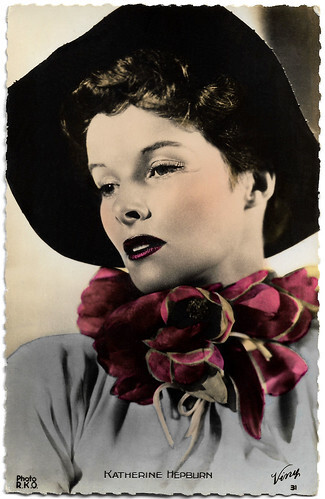
French postcard by Viny, no. 31. Photo: R.K.O.
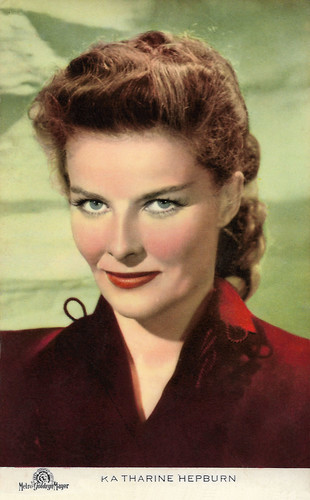
Belgian postcard by N.V. Victoria, Brussels, no. 12. Photo: Metro-Goldwyn-Mayer.
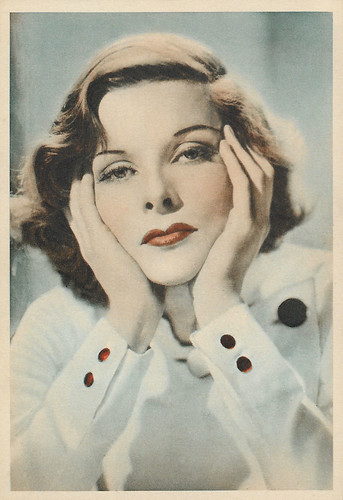
British postcard by De Reszke Cigarettes, no. 34. Photo: Radio (RKO).
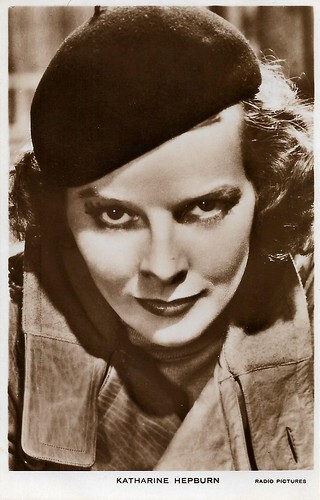
British postcard. Photo: RKO / Radio Pictures. Katharine Hepburn in Christopher Strong (Dorothy Arzner, 1933).
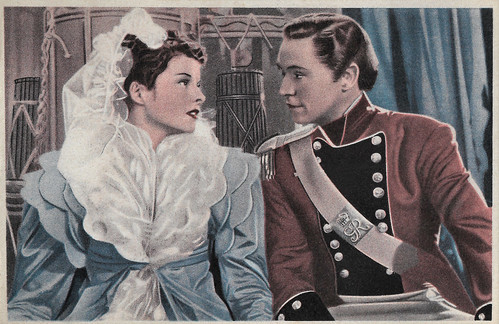
Italian postcard by Generalcine, Roma / Off. Graf. 'La Lito', Milano. Photo: RKO Radio Pictures. Publicity still for Quality Street (George Stevens, 1937) with Franchot Tone .
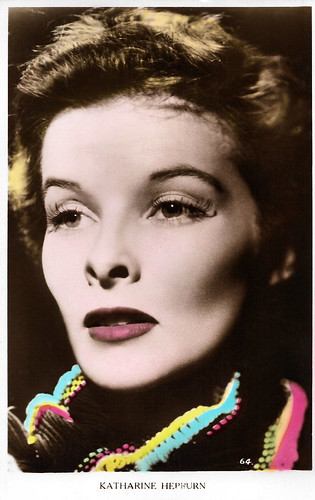
British Art Photo postcard, no. 38-1.
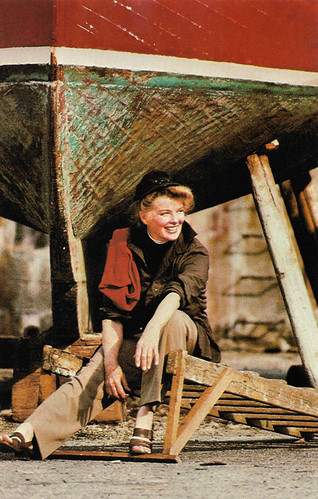
American postcard by Coral-Lee, Rancho Cordova, CA, no. CL/Personality # 130. Photo: Douglas Kirkland.
An unlikely Hollywood star
Katharine Houghton Hepburn was born in 1907 in Hartford, Connecticut, U.S.A. Her father was a wealthy and prominent Connecticut surgeon, and her mother was a leader in the women's suffrage movement.
From early childhood, Hepburn was continually encouraged to expand her intellectual horizons, speak nothing but the truth, and keep herself in top physical condition at all times. She would apply all of these ingrained values to her acting career, which began in earnest after she graduated from Bryn Mawr College in 1928.
That year, she made her Broadway debut in 'Night Hostess', appearing under the alias Katharine Burns. Hepburn scored her first major Broadway success in 'The Warrior’s Husband' (1932), a comedy set in the land of the Amazons. Shortly thereafter, she was invited to Hollywood by RKO Radio Pictures.
Hepburn was an unlikely Hollywood star. Possessing a distinctive speech pattern and an abundance of quirky mannerisms, she earned unqualified praise from her admirers and unmerciful criticism from her detractors. Unabashedly outspoken and iconoclastic, she did as she pleased, refusing to grant interviews, wearing casual clothes at a time when actresses were expected to exude glamour 24 hours a day, and openly clashing with her more experienced coworkers whenever they failed to meet her standards.
She nonetheless made an impressive film debut in George Cukor’s A Bill of Divorcement (1932), a drama that also starred John Barrymore . Hepburn was then cast as an aviator in Dorothy Arzner’s Christopher Strong (1933). For her third film, Morning Glory (Lowell Sherman, 1933), Hepburn won an Academy Award for her portrayal of an aspiring actress.
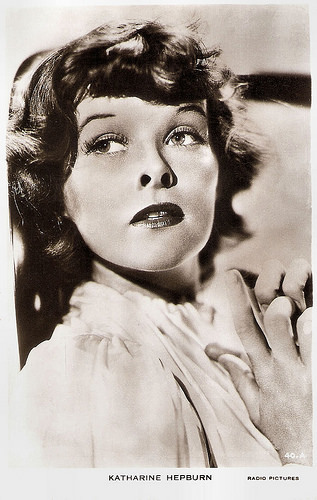
British Real Photograph postcard, no. 40. A. Photo: Radio Pictures.
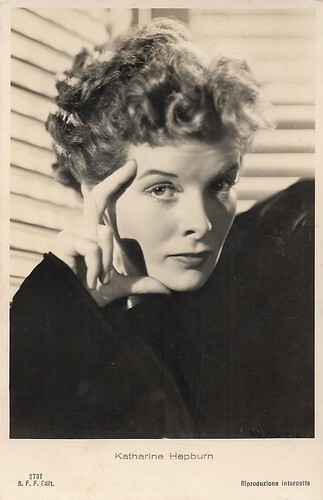
Italian postcard by B.F.F. (Ballerini & Fratini Firenze) Edit., no. 2737.
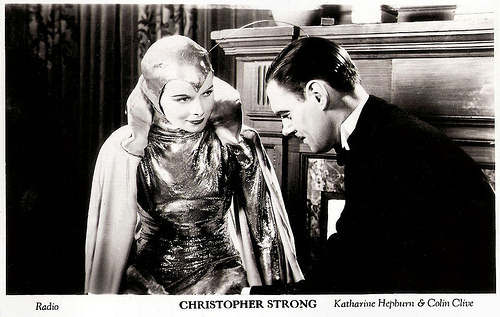
British postcard in the Filmshots series by British Weekly. Photo: Radio. Publicity still for Christopher Strong (Dorothy Arzner, 1933) with Colin Clive .
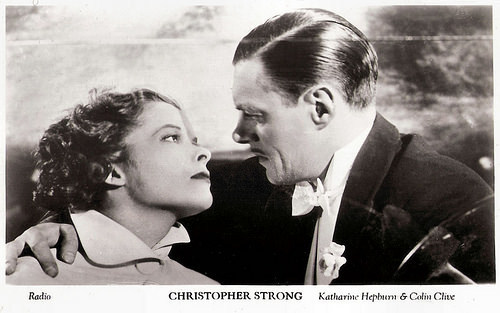
British postcard in the Filmshots series by British Weekly. Photo: Radio. Publicity still for Christopher Strong (Dorothy Arzner, 1933) with Colin Clive .
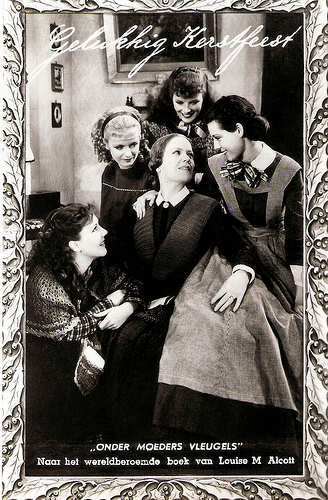
Dutch postcard by the Rialto Theatre, Amsterdam, 1934. Photo: Remaco Radio Picture. Publicity still for Little Women (George Cukor, 1933). In the picture are Katharine Hepburn, Joan Bennett , Frances Dee , Jean Parker and Spring Byington. The Dutch title of the film and the book by Louise M. Alcott is Onder moeders vleugels.
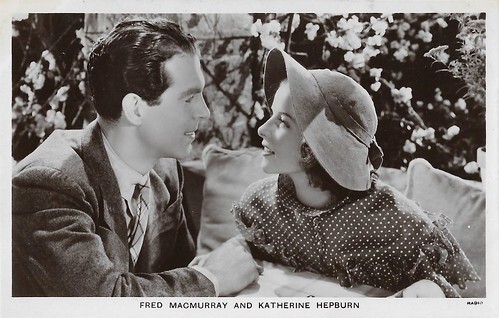
British postcard in the Film Partners Series, no. P. 183. Photo: RKO / Radio Pictures. Fred MacMurray and Katharine Hepburn in Alice Adams (George Stevens, 1935).
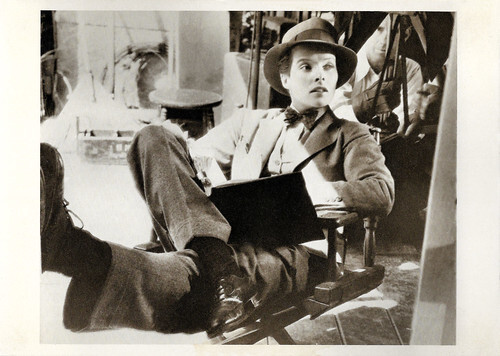
American postcard by Fotofolio, NY, NY, no. P101. Photo: Photoworld. Katharine Hepburn on the set of Sylvia Scarlett (George Cukor, 1935).
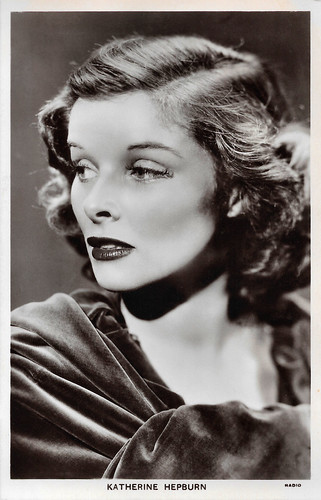
British postcard in the Picturegoer Series, no. 1045a. Photo: R.K.O. Radio.
Box office poison
However, Katharine Hepburn’s much-publicised return to Broadway, in 'The Lake' (1933), proved to be a flop. And while filmgoers enjoyed her performances in homespun entertainments such as Little Women (George Cukor, 1933) and Alice Adams (George Stevens, 1935), they were largely resistant to historical vehicles such as Mary of Scotland (John Ford, 1936), A Woman Rebels (Mark Sandrich, 1936), and Quality Street (George Stevens, 1937).
Hepburn recovered some lost ground with her sparkling performances in the screwball comedies Bringing Up Baby (Howard Hawks, 1938) and Holiday (George Cukor, 1938), both of which also starred Cary Grant . However, it was too late: a group of leading film exhibitors had already written off Hepburn as “box office poison.”
Undaunted, Hepburn accepted a role written specifically for her in Philip Barry’s 1938 Broadway comedy The Philadelphia Story, about a socialite whose ex-husband tries to win her back. Howard Hughes, Hepburn's partner at the time, sensed that the play could be her ticket back to Hollywood stardom and bought her the film rights before it even debuted on stage. It was a huge hit.
She chose to sell the rights to Metro-Goldwyn-Mayer, Hollywood's number one studio, on the condition that she be the star. As part of the deal, she also received the director of her choice, George Cukor, and picked James Stewart and Cary Grant as co-stars. The Philadelphia Story (George Cukor, 1940) was a critical and commercial success, and it jump-started her Hollywood career. She continued to make periodic returns to the stage (notably as the title character in the 1969 Broadway musical Coco), but Hepburn remained essentially a film actor for the remainder of her career.
Hepburn was also responsible for the development of her next project, the romantic comedy Woman of the Year (George Stevens, 1942), about a political columnist and a sports reporter whose relationship is threatened by her self-centred independence. The idea for the film was proposed to her by Garson Kanin in 1941, who recalled how Hepburn contributed to the script. She presented the finished product to MGM and demanded $250,000—half for her, and half for the authors. Her terms accepted, Hepburn was also given the director and co-star of her choice, George Stevens and Spencer Tracy . Woman of the Year was another success. Critics praised the chemistry between the stars.
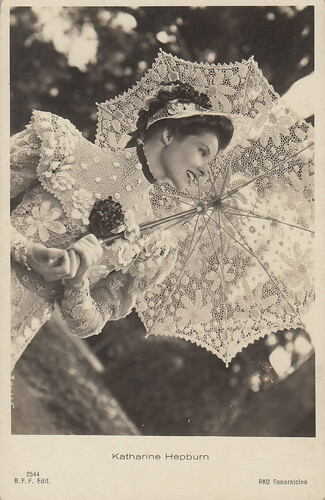
Italian postcard by Ballerini & Fratini, Firenze, no. 2544. Photo: RKO / Generalcine. Katharine Hepburn in Quality Street (George Stevens, 1937). Collection: Marlene Pilaete.
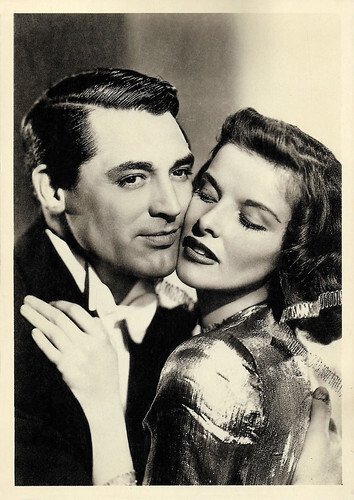
French postcard in the Collection 'Portraits de Cinema' (4th series, no. 2) by Editions Admira & Chapman Collection / SNAP Photos / Cosmos, no. PHN 662, 1989. Cary Grant and Katharine Hepburn in Bringing Up Baby (Howard Hawks, 1938).
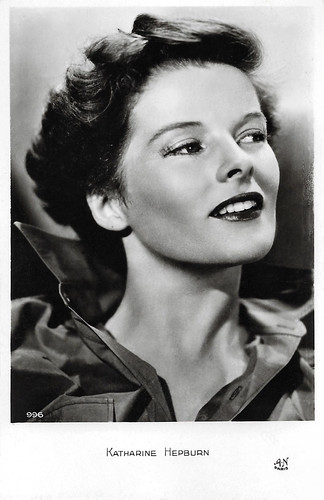
French postcard by A.N., Paris, Paris, no. 996.
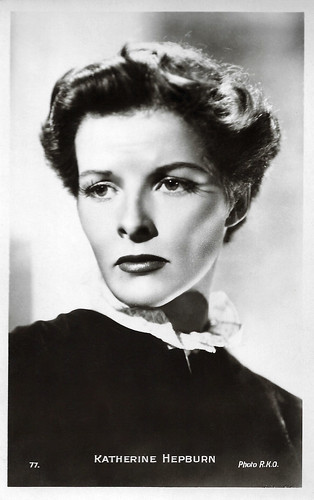
French postcard by Edition Chantal, Paris, no. 77. Photo: R.K.O.
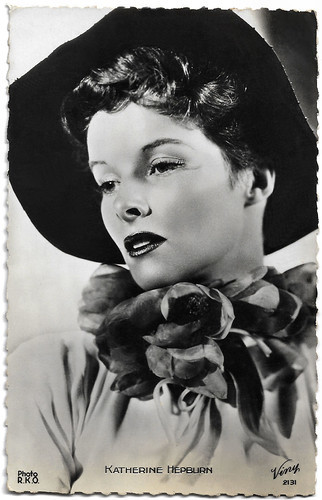
French postcard by Viny, no. 2131. Photo: R.K.O.
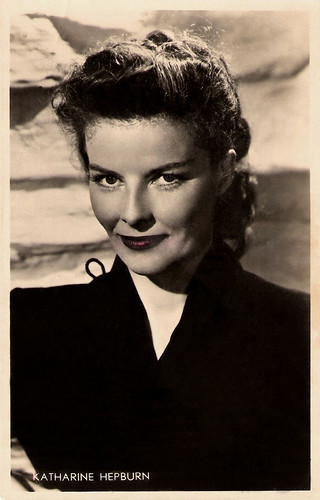
Dutch postcard by S & v. H., Amsterdam.
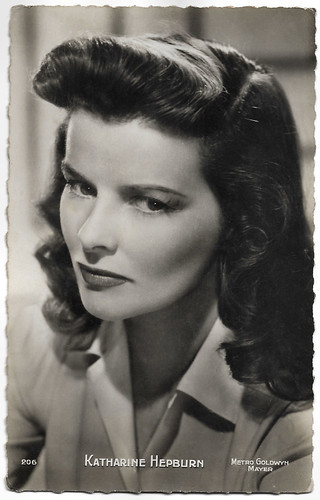
French postcard by Editions P.I., no. 206. Photo: Metro-Goldwyn-Mayer, 1950. Although the postcard was produced in 1950, the photo was taken much earlier, probably for The Philadelphia Story (George Cukor, 1940).
An unprecedented fourth Oscar
Katharine Hepburn's stature increased in the following decades as she chalked up such cinematic triumphs as John Huston ’s The African Queen (1951), in which she played a missionary who escapes German troops with the aid of a riverboat captain ( Humphrey Bogart ), and David Lean’s Summertime (1955), a love story set in Venice. Hepburn received an Academy Award nomination for the second year running for her work opposite Burt Lancaster in The Rainmaker (Joseph Anthony, 1956). Again she played a lonely woman empowered by a love affair, and it became apparent that Hepburn had found a niche in playing 'love-starved spinsters' that critics and audiences enjoyed.
After two years away from the screen, Hepburn starred in a film adaptation of Tennessee Williams' controversial play Suddenly, Last Summer (1959) with Elizabeth Taylor and Montgomery Clift . She clashed with director Joseph L. Mankiewicz during filming, which culminated with her spitting at him in disgust. The picture was a financial success, and her work as creepy aunt Violet Venable gave Hepburn her eighth Oscar nomination. In Long Day’s Journey into Night (Sidney Lumet, 1962), an adaptation of Eugene O’Neill’s acclaimed play, Hepburn was cast as a drug-addicted mother, opposite Ralph Richardson , Jason Robards and Dean Stockwell . Long Day's Journey Into Night earned Hepburn an Oscar nomination and the Best Actress Award at the Cannes Film Festival. It remains one of her most praised performances.
Katharine Hepburn won a second Academy Award for Guess Who’s Coming to Dinner (Stanley Kramer, 1967), a dramedy about interracial marriage; a third for The Lion in Winter (Anthony Harvey, 1968), in which she played Eleanor of Aquitaine opposite Peter O'Toole as King Henry II; and an unprecedented fourth Oscar for On Golden Pond (Mark Rydell, 1981), about long-married New Englanders (Hepburn and Henry Fonda ). Her 12 Academy Award nominations also set a record, which stood until 2003, when broken by Meryl Streep . In addition, Hepburn appeared frequently on television in the 1970s and 1980s. She was nominated for an Emmy Award for her memorable portrayal of Amanda Wingfield in Tennessee Williams’s The Glass Menagerie (Anthony Harvey, 1973), and she won the award for her performance opposite Laurence Olivier in Love Among the Ruins (1975), which reunited her with her favourite director, George Cukor.
Though hampered by a progressive neurological disease, Hepburn was nonetheless still active in the early 1990s, appearing prominently in films such as Love Affair (Glenn Gordon Caron, 1994), which was her last film. At 87 years old, she played a supporting role, alongside Annette Bening and Warren Beatty . It was the only film of Hepburn's career, other than the cameo appearance in Stage Door Canteen (Frank Borzage, 1943), in which she did not play a leading role. Hepburn was married once. In 1928, she wed Philadelphia broker Ludlow Ogden Smith, but the union was dissolved in 1934. While filming Woman of the Year in 1942, she began an enduring intimate relationship with her costar, Spencer Tracy , with whom she would appear in films such as Adam’s Rib (1949) and Pat and Mike (1952); both were directed by George Cukor.
Tracy and Hepburn never married — he was Roman Catholic and would not divorce his wife — but they remained close both personally and professionally until his death in 1967, just days after completing the filming of Guess Who’s Coming to Dinner. Hepburn had suspended her own career for nearly five years to nurse Tracy through what turned out to be his final illness. In 1999, the American Film Institute named Hepburn the top female American screen legend of all time. She wrote several memoirs, including 'Me: Stories of My Life' (1991). Katharine Hepburn died in 2003 in Old Saybrook, Connecticut. She was 96.
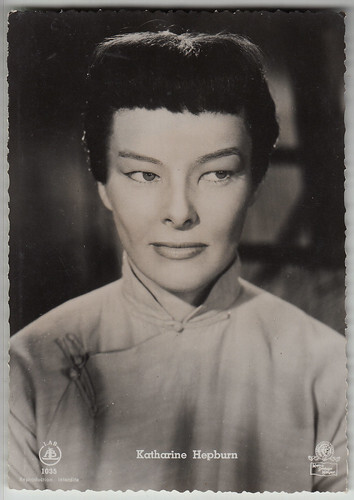
Belgian postcard by Editions L.A.B., Bruxelles, no. 1035. Photo: Metro-Goldwyn-Mayer. Katharine Hepburn, as Chinese character Jade Tan, in Dragon Seed (Harold S. Bucquet, Jack Conway, 1944). Collection: Marlene Pilaete.
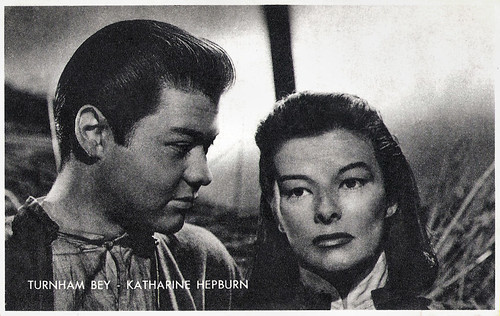
Belgian Collectors Card by Kwatta, Bois d'Haine, no. C. 159. Photo: Metro-Goldwyn-Mayer. Publicity still for Dragon Seed (Harold S. Bucquet, Jack Conway, 1944) with Turhan Bey.
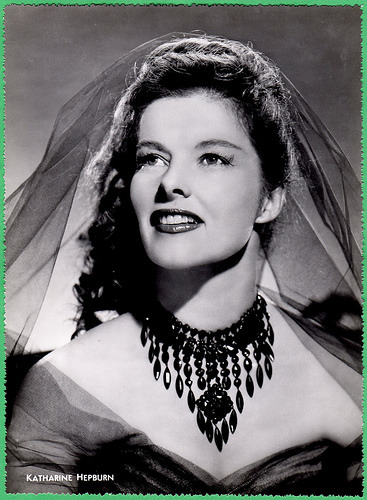
Belgian collectors card by Chocolaterie Clovis, Pepinster. Collection: Amit Benyovits. Katharine Hepburn in Song of Love (Clarence Brown, 1947).
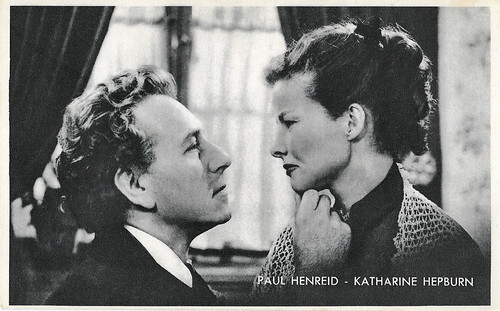
Belgian collector card by Kwatta. Photo: M.G.M. Paul Henreid and Katharine Hepburn in Song of Love (Clarence Brown, 1947).
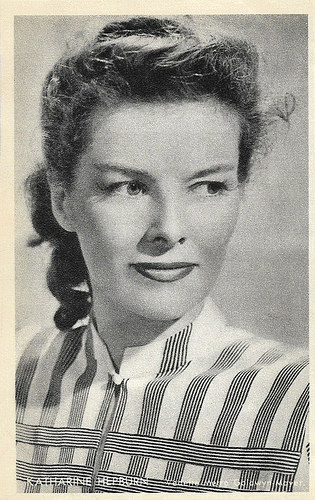
Belgian Collectors Card by Kwatta, Bois d'Haine. Photo: Metro-Goldwyn-Mayer. Collection: Geoffrey Donaldson Institute.
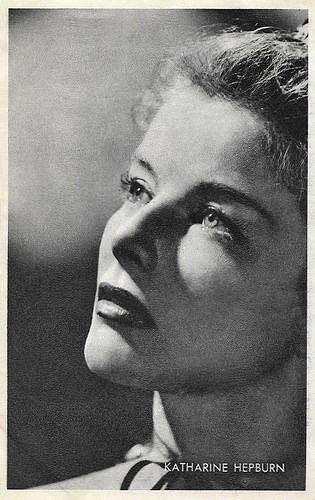
Belgian Collectors Card by Kwatta, Bois d'Haine, no. C. 110. Photo: Metro-Goldwyn-Mayer. Collection: Geoffrey Donaldson Institute.
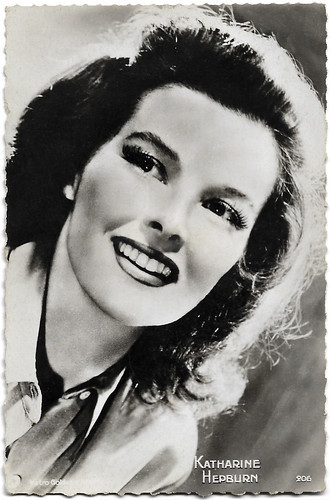
French postcard by Editions P.I., no. 206. Photo: Metro-Goldwyn-Mayer. (Miraculously, the card has the same credits as this card).
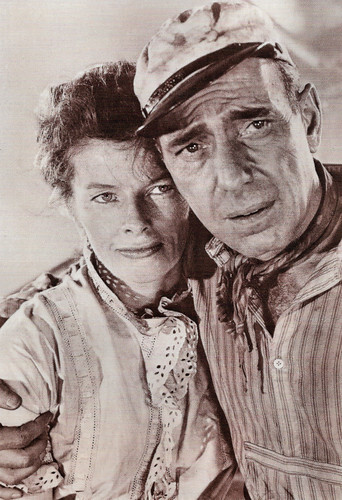
American postcard by Classico San Francisco, no. 136-208. Photo: The Ludlow Collection. Katharine Hepburn and Humphrey Bogart in The African Queen (John Huston, 1951).
Sources: Encyclopaedia Britannica, Wikipedia and .

French postcard by Viny, no. 31. Photo: R.K.O.

Belgian postcard by N.V. Victoria, Brussels, no. 12. Photo: Metro-Goldwyn-Mayer.

British postcard by De Reszke Cigarettes, no. 34. Photo: Radio (RKO).

British postcard. Photo: RKO / Radio Pictures. Katharine Hepburn in Christopher Strong (Dorothy Arzner, 1933).

Italian postcard by Generalcine, Roma / Off. Graf. 'La Lito', Milano. Photo: RKO Radio Pictures. Publicity still for Quality Street (George Stevens, 1937) with Franchot Tone .

British Art Photo postcard, no. 38-1.

American postcard by Coral-Lee, Rancho Cordova, CA, no. CL/Personality # 130. Photo: Douglas Kirkland.
An unlikely Hollywood star
Katharine Houghton Hepburn was born in 1907 in Hartford, Connecticut, U.S.A. Her father was a wealthy and prominent Connecticut surgeon, and her mother was a leader in the women's suffrage movement.
From early childhood, Hepburn was continually encouraged to expand her intellectual horizons, speak nothing but the truth, and keep herself in top physical condition at all times. She would apply all of these ingrained values to her acting career, which began in earnest after she graduated from Bryn Mawr College in 1928.
That year, she made her Broadway debut in 'Night Hostess', appearing under the alias Katharine Burns. Hepburn scored her first major Broadway success in 'The Warrior’s Husband' (1932), a comedy set in the land of the Amazons. Shortly thereafter, she was invited to Hollywood by RKO Radio Pictures.
Hepburn was an unlikely Hollywood star. Possessing a distinctive speech pattern and an abundance of quirky mannerisms, she earned unqualified praise from her admirers and unmerciful criticism from her detractors. Unabashedly outspoken and iconoclastic, she did as she pleased, refusing to grant interviews, wearing casual clothes at a time when actresses were expected to exude glamour 24 hours a day, and openly clashing with her more experienced coworkers whenever they failed to meet her standards.
She nonetheless made an impressive film debut in George Cukor’s A Bill of Divorcement (1932), a drama that also starred John Barrymore . Hepburn was then cast as an aviator in Dorothy Arzner’s Christopher Strong (1933). For her third film, Morning Glory (Lowell Sherman, 1933), Hepburn won an Academy Award for her portrayal of an aspiring actress.

British Real Photograph postcard, no. 40. A. Photo: Radio Pictures.

Italian postcard by B.F.F. (Ballerini & Fratini Firenze) Edit., no. 2737.

British postcard in the Filmshots series by British Weekly. Photo: Radio. Publicity still for Christopher Strong (Dorothy Arzner, 1933) with Colin Clive .

British postcard in the Filmshots series by British Weekly. Photo: Radio. Publicity still for Christopher Strong (Dorothy Arzner, 1933) with Colin Clive .

Dutch postcard by the Rialto Theatre, Amsterdam, 1934. Photo: Remaco Radio Picture. Publicity still for Little Women (George Cukor, 1933). In the picture are Katharine Hepburn, Joan Bennett , Frances Dee , Jean Parker and Spring Byington. The Dutch title of the film and the book by Louise M. Alcott is Onder moeders vleugels.

British postcard in the Film Partners Series, no. P. 183. Photo: RKO / Radio Pictures. Fred MacMurray and Katharine Hepburn in Alice Adams (George Stevens, 1935).

American postcard by Fotofolio, NY, NY, no. P101. Photo: Photoworld. Katharine Hepburn on the set of Sylvia Scarlett (George Cukor, 1935).

British postcard in the Picturegoer Series, no. 1045a. Photo: R.K.O. Radio.
Box office poison
However, Katharine Hepburn’s much-publicised return to Broadway, in 'The Lake' (1933), proved to be a flop. And while filmgoers enjoyed her performances in homespun entertainments such as Little Women (George Cukor, 1933) and Alice Adams (George Stevens, 1935), they were largely resistant to historical vehicles such as Mary of Scotland (John Ford, 1936), A Woman Rebels (Mark Sandrich, 1936), and Quality Street (George Stevens, 1937).
Hepburn recovered some lost ground with her sparkling performances in the screwball comedies Bringing Up Baby (Howard Hawks, 1938) and Holiday (George Cukor, 1938), both of which also starred Cary Grant . However, it was too late: a group of leading film exhibitors had already written off Hepburn as “box office poison.”
Undaunted, Hepburn accepted a role written specifically for her in Philip Barry’s 1938 Broadway comedy The Philadelphia Story, about a socialite whose ex-husband tries to win her back. Howard Hughes, Hepburn's partner at the time, sensed that the play could be her ticket back to Hollywood stardom and bought her the film rights before it even debuted on stage. It was a huge hit.
She chose to sell the rights to Metro-Goldwyn-Mayer, Hollywood's number one studio, on the condition that she be the star. As part of the deal, she also received the director of her choice, George Cukor, and picked James Stewart and Cary Grant as co-stars. The Philadelphia Story (George Cukor, 1940) was a critical and commercial success, and it jump-started her Hollywood career. She continued to make periodic returns to the stage (notably as the title character in the 1969 Broadway musical Coco), but Hepburn remained essentially a film actor for the remainder of her career.
Hepburn was also responsible for the development of her next project, the romantic comedy Woman of the Year (George Stevens, 1942), about a political columnist and a sports reporter whose relationship is threatened by her self-centred independence. The idea for the film was proposed to her by Garson Kanin in 1941, who recalled how Hepburn contributed to the script. She presented the finished product to MGM and demanded $250,000—half for her, and half for the authors. Her terms accepted, Hepburn was also given the director and co-star of her choice, George Stevens and Spencer Tracy . Woman of the Year was another success. Critics praised the chemistry between the stars.

Italian postcard by Ballerini & Fratini, Firenze, no. 2544. Photo: RKO / Generalcine. Katharine Hepburn in Quality Street (George Stevens, 1937). Collection: Marlene Pilaete.

French postcard in the Collection 'Portraits de Cinema' (4th series, no. 2) by Editions Admira & Chapman Collection / SNAP Photos / Cosmos, no. PHN 662, 1989. Cary Grant and Katharine Hepburn in Bringing Up Baby (Howard Hawks, 1938).

French postcard by A.N., Paris, Paris, no. 996.

French postcard by Edition Chantal, Paris, no. 77. Photo: R.K.O.

French postcard by Viny, no. 2131. Photo: R.K.O.

Dutch postcard by S & v. H., Amsterdam.

French postcard by Editions P.I., no. 206. Photo: Metro-Goldwyn-Mayer, 1950. Although the postcard was produced in 1950, the photo was taken much earlier, probably for The Philadelphia Story (George Cukor, 1940).
An unprecedented fourth Oscar
Katharine Hepburn's stature increased in the following decades as she chalked up such cinematic triumphs as John Huston ’s The African Queen (1951), in which she played a missionary who escapes German troops with the aid of a riverboat captain ( Humphrey Bogart ), and David Lean’s Summertime (1955), a love story set in Venice. Hepburn received an Academy Award nomination for the second year running for her work opposite Burt Lancaster in The Rainmaker (Joseph Anthony, 1956). Again she played a lonely woman empowered by a love affair, and it became apparent that Hepburn had found a niche in playing 'love-starved spinsters' that critics and audiences enjoyed.
After two years away from the screen, Hepburn starred in a film adaptation of Tennessee Williams' controversial play Suddenly, Last Summer (1959) with Elizabeth Taylor and Montgomery Clift . She clashed with director Joseph L. Mankiewicz during filming, which culminated with her spitting at him in disgust. The picture was a financial success, and her work as creepy aunt Violet Venable gave Hepburn her eighth Oscar nomination. In Long Day’s Journey into Night (Sidney Lumet, 1962), an adaptation of Eugene O’Neill’s acclaimed play, Hepburn was cast as a drug-addicted mother, opposite Ralph Richardson , Jason Robards and Dean Stockwell . Long Day's Journey Into Night earned Hepburn an Oscar nomination and the Best Actress Award at the Cannes Film Festival. It remains one of her most praised performances.
Katharine Hepburn won a second Academy Award for Guess Who’s Coming to Dinner (Stanley Kramer, 1967), a dramedy about interracial marriage; a third for The Lion in Winter (Anthony Harvey, 1968), in which she played Eleanor of Aquitaine opposite Peter O'Toole as King Henry II; and an unprecedented fourth Oscar for On Golden Pond (Mark Rydell, 1981), about long-married New Englanders (Hepburn and Henry Fonda ). Her 12 Academy Award nominations also set a record, which stood until 2003, when broken by Meryl Streep . In addition, Hepburn appeared frequently on television in the 1970s and 1980s. She was nominated for an Emmy Award for her memorable portrayal of Amanda Wingfield in Tennessee Williams’s The Glass Menagerie (Anthony Harvey, 1973), and she won the award for her performance opposite Laurence Olivier in Love Among the Ruins (1975), which reunited her with her favourite director, George Cukor.
Though hampered by a progressive neurological disease, Hepburn was nonetheless still active in the early 1990s, appearing prominently in films such as Love Affair (Glenn Gordon Caron, 1994), which was her last film. At 87 years old, she played a supporting role, alongside Annette Bening and Warren Beatty . It was the only film of Hepburn's career, other than the cameo appearance in Stage Door Canteen (Frank Borzage, 1943), in which she did not play a leading role. Hepburn was married once. In 1928, she wed Philadelphia broker Ludlow Ogden Smith, but the union was dissolved in 1934. While filming Woman of the Year in 1942, she began an enduring intimate relationship with her costar, Spencer Tracy , with whom she would appear in films such as Adam’s Rib (1949) and Pat and Mike (1952); both were directed by George Cukor.
Tracy and Hepburn never married — he was Roman Catholic and would not divorce his wife — but they remained close both personally and professionally until his death in 1967, just days after completing the filming of Guess Who’s Coming to Dinner. Hepburn had suspended her own career for nearly five years to nurse Tracy through what turned out to be his final illness. In 1999, the American Film Institute named Hepburn the top female American screen legend of all time. She wrote several memoirs, including 'Me: Stories of My Life' (1991). Katharine Hepburn died in 2003 in Old Saybrook, Connecticut. She was 96.

Belgian postcard by Editions L.A.B., Bruxelles, no. 1035. Photo: Metro-Goldwyn-Mayer. Katharine Hepburn, as Chinese character Jade Tan, in Dragon Seed (Harold S. Bucquet, Jack Conway, 1944). Collection: Marlene Pilaete.

Belgian Collectors Card by Kwatta, Bois d'Haine, no. C. 159. Photo: Metro-Goldwyn-Mayer. Publicity still for Dragon Seed (Harold S. Bucquet, Jack Conway, 1944) with Turhan Bey.

Belgian collectors card by Chocolaterie Clovis, Pepinster. Collection: Amit Benyovits. Katharine Hepburn in Song of Love (Clarence Brown, 1947).

Belgian collector card by Kwatta. Photo: M.G.M. Paul Henreid and Katharine Hepburn in Song of Love (Clarence Brown, 1947).

Belgian Collectors Card by Kwatta, Bois d'Haine. Photo: Metro-Goldwyn-Mayer. Collection: Geoffrey Donaldson Institute.

Belgian Collectors Card by Kwatta, Bois d'Haine, no. C. 110. Photo: Metro-Goldwyn-Mayer. Collection: Geoffrey Donaldson Institute.

French postcard by Editions P.I., no. 206. Photo: Metro-Goldwyn-Mayer. (Miraculously, the card has the same credits as this card).

American postcard by Classico San Francisco, no. 136-208. Photo: The Ludlow Collection. Katharine Hepburn and Humphrey Bogart in The African Queen (John Huston, 1951).
Sources: Encyclopaedia Britannica, Wikipedia and .
Published on June 20, 2025 22:00
June 19, 2025
Richard Conte
Richard Conte (1910-1975) was an American actor, who often appeared in Film Noirs and crime dramas of the late 1940s and early 1950s. Two decades later, he returned to the screen as gangster boss Don Barzini in The Godfather (1972).
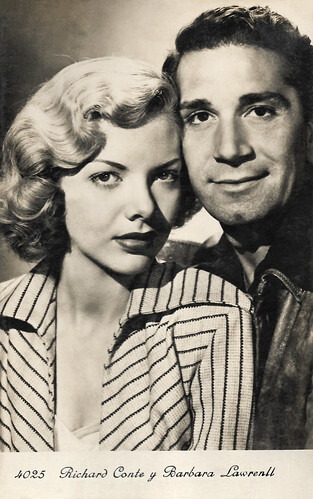
Spanish postcard, no. 4025. Richard Conte and Barbara Lawrence in Thieves' Highway (Jules Dassin, 1949).
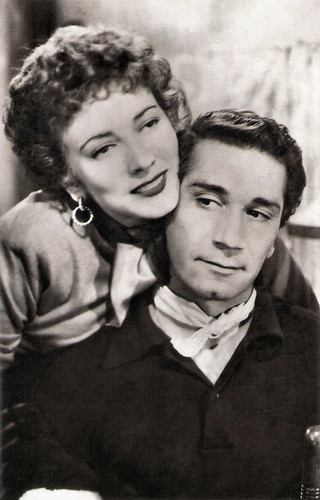
Spanish postcard by Sobe, no. 638. Valentina Cortese and Richard Conte in Thieves' Highway (Jules Dassin, 1949).
The 'New John Garfield'
Nicholas Peter Conte was born in Jersey City, New Jersey, in 1910. He was the son of Pasquale Conte, an Italian-American barber and his wife, Giulia Fina, a seamstress. Before becoming an actor, he held a series of jobs, from truck driver to shoe salesman to messenger on Wall Street.
In 1935, he was discovered by Elia Kazan and John Garfield , director and actor respectively of New York City's Group Theatre Company, at a resort in Connecticut, where Conte had a job as a singing waiter. Through them, he gained access to the theatre world. With Kazan's help, he earned a scholarship to study at the Neighbourhood Playhouse in New York, where he became a standout student. He made his Broadway debut in 'My Heart's in the Highlands' (1939) for the Group Theatre. Also for the Group, he was in Clifford Odets' 'Night Music' (1940). He also performed in the road company of 'Golden Boy'. On Broadway, he was in 'Heavenly Express' (1941) and 'Walk Into My Parlor' (1941). He was a hit in 'Jason' (1942) and then was in 'The Family' (1943).
In 1939, he also made his film debut in Heaven with a Barbed Fence (Ricardo Cortez, 1939), written by Dalton Trumbo. He played Tony, a hobo who meets up with Joe ( Glenn Ford who was also making his film debut) and Anita (Jean Rogers). The three of them make their way west hopping trains. During World War II, Conte served in the United States Army, but he was discharged because of eye trouble.
Conte's film career took off during the war period. Many actors had been recruited and were serving in the military. In 1943, Conte signed a long-term contract with 20th Century Fox and changed his name from Nicholas Conte to Richard Conte. Ironically, he was promoted as the 'New John Garfield', the man who helped discover him. His first Fox film was the War film Guadalcanal Diary (Lewis Seiler, 1943), where he was billed fourth.
He followed it with another war drama, The Purple Heart (Lewis Milestone, 1944) in which he was billed second, beneath Dana Andrews . Conte had a smaller part in Captain Eddie (Lloyd Bacon, 1945), a biopic about Eddie Rickenbacker ( Fred MacMurray ), and played an Italian POW in A Bell for Adano (Henry King, 1945) starring Gene Tierney . Conte had the starring role in another war film for Lewis Milestone, A Walk in the Sun (Lewis Milestone, 1945), again with Dana Andrews .
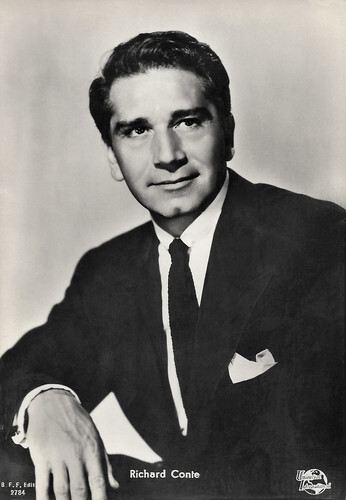
Italian postcard by Casa Editr. Ballerini & Fratini, Firenze (B.F.F.), no. 2784. Photo: Universal International.
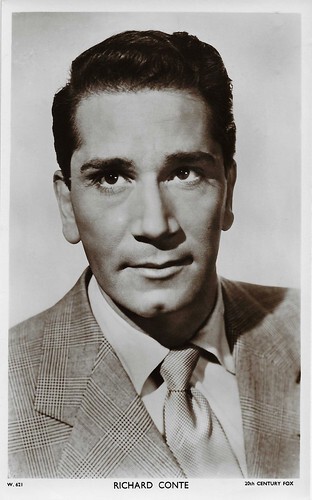
British postcard in the Picturegoer Series, London, no. W. 621. Photo: 20th Century Fox.
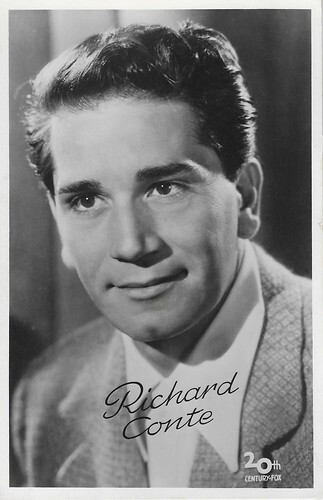
Dutch postcard by Takken / 't Sticht, no. 3138. Photo: 20th Century Fox. Collection: Geoffrey Donaldson Institute.
Centre stage in Film Noir
After the war, Richard Conte alternated roles in minor films with major productions. Fox promoted Conte to top billing with the Film Noir The Spider (Robert D. Webb, 1945). Although a B film for the studio, it was successful enough to establish Conte in Film Noir. Soon followed supporting roles in Somewhere in the Night (Joseph Mankiewicz, 1946) and the Spy film 13 Rue Madeleine (1946), directed by Henry Hathaway.
In Film Noir and gangster roles his stern face and powerful physique put him centre stage, even in supporting roles. His best work includes the innocently captured man in Call Northside 777 (Henry Hathaway, 1947) with James Stewart and the lead role as a truck driver in Thieves' Highway (Jules Dassin, 1949). He also co-starred with Gene Tierney in Otto Preminger's Film Noir Whirlpool (1950).
In the 1950s, his contract at Fox was terminated. He then starred mainly in B-movies such as The Blue Gardenia (Fritz Lang, 1953) and Highway Dragnet (Nathan Juran, 1954) with Joan Bennett . He then went to England to make Mask of Dust (Terence Fisher, 1954) for Hammer Films. Back in the U.S., Conte played a vicious but philosophical gangster in the Film Noir classic The Big Combo (Joseph H. Lewis, 1955) and had the second lead in I'll Cry Tomorrow (Daniel Mann, 1955), an MGM biopic about Lillian Roth starring Susan Hayward .
Conte also appeared frequently on television, in such series as The Twilight Zone and Alfred Hitchcock Presents. It culminated in a starring role in the series The Four Just Men (1959-1960). As interest in Film Noir waned in the 1960s, Richard Conte's career seemed to stall. He appeared with Frank Sinatra in the Heist film Ocean's Eleven (Lewis Milestone, 1960). Sinatra gave him the role of Lt. Dave Santini in his crime film Tony Rome (Gordon Douglas, 1967) and its sequel Lady in Cement (Gordon Douglas, 1968). Eventually, Conte left for Europe, where he starred in the Spaghetti Western Sentenza di more / Death Sentence (Mario Lanfranchi, 1968) and directed Operation Cross Eagles (Richard Conte, 1969), filmed entirely in Yugoslavia.
He returned to the US in the early 1970s to play the role of Don Emilio Barzini, Don Vito Corleone's chief rival in The Godfather (Francis Ford Coppola, 1972). Conte himself was briefly in the running to play the role of Don Corleone, but that role eventually went to Marlon Brando . After The Godfather, he returned to Europe, appearing in several Italian films, including Anastasia mio fratello / My Brother Anastasia (Steno, 1973) with Alberto Sordi and the Poliziottesco Roma violenta / Violent Rome (Marino Girolami, 1975). The second was a huge box office hit in Italy and launched the career of actor Maurizio Merli. In 1975, Conte died of a heart attack in Los Angeles. He was 65 years old. Richard Conte was married twice, to actress Ruth Storey from 1943 to 1962 and to Shirlee Garner from 1973 until he died in 1975. Together with Storey, he had an adopted son, Mark Conte, who would later become an editor. Richard Conte is buried in Westwood Memorial Park in Los Angeles.
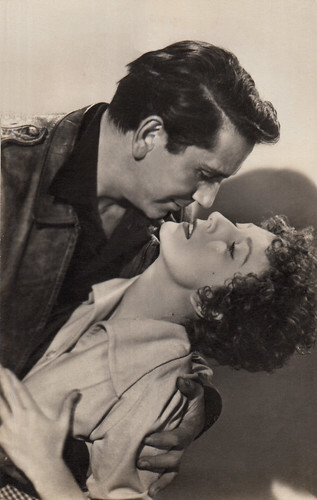
Spanish postcard by Sobe, no. 691. Valentina Cortese and Richard Conte in Thieves' Highway (Jules Dassin, 1949). Collection: Marlene Pilaete.
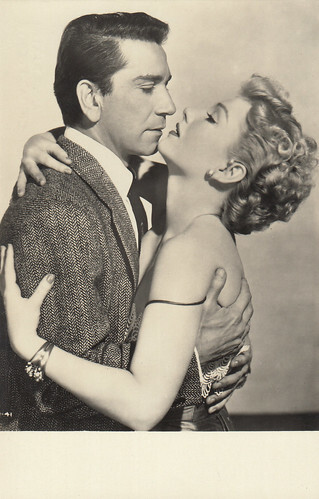
Spanish postcard. Anne Baxter and Richard Conte in The Blue Gardenia (Fritz Lang, 1953). Collection: Marlène Pilaete.
Sources: (IMDb), Wikipedia (Dutch, Italian and English) and .

Spanish postcard, no. 4025. Richard Conte and Barbara Lawrence in Thieves' Highway (Jules Dassin, 1949).

Spanish postcard by Sobe, no. 638. Valentina Cortese and Richard Conte in Thieves' Highway (Jules Dassin, 1949).
The 'New John Garfield'
Nicholas Peter Conte was born in Jersey City, New Jersey, in 1910. He was the son of Pasquale Conte, an Italian-American barber and his wife, Giulia Fina, a seamstress. Before becoming an actor, he held a series of jobs, from truck driver to shoe salesman to messenger on Wall Street.
In 1935, he was discovered by Elia Kazan and John Garfield , director and actor respectively of New York City's Group Theatre Company, at a resort in Connecticut, where Conte had a job as a singing waiter. Through them, he gained access to the theatre world. With Kazan's help, he earned a scholarship to study at the Neighbourhood Playhouse in New York, where he became a standout student. He made his Broadway debut in 'My Heart's in the Highlands' (1939) for the Group Theatre. Also for the Group, he was in Clifford Odets' 'Night Music' (1940). He also performed in the road company of 'Golden Boy'. On Broadway, he was in 'Heavenly Express' (1941) and 'Walk Into My Parlor' (1941). He was a hit in 'Jason' (1942) and then was in 'The Family' (1943).
In 1939, he also made his film debut in Heaven with a Barbed Fence (Ricardo Cortez, 1939), written by Dalton Trumbo. He played Tony, a hobo who meets up with Joe ( Glenn Ford who was also making his film debut) and Anita (Jean Rogers). The three of them make their way west hopping trains. During World War II, Conte served in the United States Army, but he was discharged because of eye trouble.
Conte's film career took off during the war period. Many actors had been recruited and were serving in the military. In 1943, Conte signed a long-term contract with 20th Century Fox and changed his name from Nicholas Conte to Richard Conte. Ironically, he was promoted as the 'New John Garfield', the man who helped discover him. His first Fox film was the War film Guadalcanal Diary (Lewis Seiler, 1943), where he was billed fourth.
He followed it with another war drama, The Purple Heart (Lewis Milestone, 1944) in which he was billed second, beneath Dana Andrews . Conte had a smaller part in Captain Eddie (Lloyd Bacon, 1945), a biopic about Eddie Rickenbacker ( Fred MacMurray ), and played an Italian POW in A Bell for Adano (Henry King, 1945) starring Gene Tierney . Conte had the starring role in another war film for Lewis Milestone, A Walk in the Sun (Lewis Milestone, 1945), again with Dana Andrews .

Italian postcard by Casa Editr. Ballerini & Fratini, Firenze (B.F.F.), no. 2784. Photo: Universal International.

British postcard in the Picturegoer Series, London, no. W. 621. Photo: 20th Century Fox.

Dutch postcard by Takken / 't Sticht, no. 3138. Photo: 20th Century Fox. Collection: Geoffrey Donaldson Institute.
Centre stage in Film Noir
After the war, Richard Conte alternated roles in minor films with major productions. Fox promoted Conte to top billing with the Film Noir The Spider (Robert D. Webb, 1945). Although a B film for the studio, it was successful enough to establish Conte in Film Noir. Soon followed supporting roles in Somewhere in the Night (Joseph Mankiewicz, 1946) and the Spy film 13 Rue Madeleine (1946), directed by Henry Hathaway.
In Film Noir and gangster roles his stern face and powerful physique put him centre stage, even in supporting roles. His best work includes the innocently captured man in Call Northside 777 (Henry Hathaway, 1947) with James Stewart and the lead role as a truck driver in Thieves' Highway (Jules Dassin, 1949). He also co-starred with Gene Tierney in Otto Preminger's Film Noir Whirlpool (1950).
In the 1950s, his contract at Fox was terminated. He then starred mainly in B-movies such as The Blue Gardenia (Fritz Lang, 1953) and Highway Dragnet (Nathan Juran, 1954) with Joan Bennett . He then went to England to make Mask of Dust (Terence Fisher, 1954) for Hammer Films. Back in the U.S., Conte played a vicious but philosophical gangster in the Film Noir classic The Big Combo (Joseph H. Lewis, 1955) and had the second lead in I'll Cry Tomorrow (Daniel Mann, 1955), an MGM biopic about Lillian Roth starring Susan Hayward .
Conte also appeared frequently on television, in such series as The Twilight Zone and Alfred Hitchcock Presents. It culminated in a starring role in the series The Four Just Men (1959-1960). As interest in Film Noir waned in the 1960s, Richard Conte's career seemed to stall. He appeared with Frank Sinatra in the Heist film Ocean's Eleven (Lewis Milestone, 1960). Sinatra gave him the role of Lt. Dave Santini in his crime film Tony Rome (Gordon Douglas, 1967) and its sequel Lady in Cement (Gordon Douglas, 1968). Eventually, Conte left for Europe, where he starred in the Spaghetti Western Sentenza di more / Death Sentence (Mario Lanfranchi, 1968) and directed Operation Cross Eagles (Richard Conte, 1969), filmed entirely in Yugoslavia.
He returned to the US in the early 1970s to play the role of Don Emilio Barzini, Don Vito Corleone's chief rival in The Godfather (Francis Ford Coppola, 1972). Conte himself was briefly in the running to play the role of Don Corleone, but that role eventually went to Marlon Brando . After The Godfather, he returned to Europe, appearing in several Italian films, including Anastasia mio fratello / My Brother Anastasia (Steno, 1973) with Alberto Sordi and the Poliziottesco Roma violenta / Violent Rome (Marino Girolami, 1975). The second was a huge box office hit in Italy and launched the career of actor Maurizio Merli. In 1975, Conte died of a heart attack in Los Angeles. He was 65 years old. Richard Conte was married twice, to actress Ruth Storey from 1943 to 1962 and to Shirlee Garner from 1973 until he died in 1975. Together with Storey, he had an adopted son, Mark Conte, who would later become an editor. Richard Conte is buried in Westwood Memorial Park in Los Angeles.

Spanish postcard by Sobe, no. 691. Valentina Cortese and Richard Conte in Thieves' Highway (Jules Dassin, 1949). Collection: Marlene Pilaete.

Spanish postcard. Anne Baxter and Richard Conte in The Blue Gardenia (Fritz Lang, 1953). Collection: Marlène Pilaete.
Sources: (IMDb), Wikipedia (Dutch, Italian and English) and .
Published on June 19, 2025 22:00
June 18, 2025
Sissy Spacek
Sissy Spacek (1949) is an American actress and singer with an enduring and award-winning career in film and television. She became a star with her Oscar-nominated performance in Carrie (1976), in which she played a humiliated prom queen who goes postal with her telekinesis. She won the Oscar for Best Actress for her performance as country singer Loretta Lynn in Coal Miner's Daughter (1980).
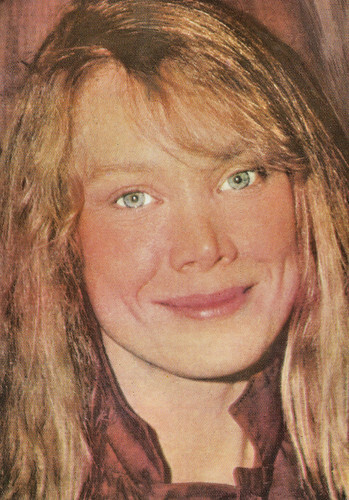
Romanian postcard by Casa Filmului Acin, C.P.C.S. Cda 33132.
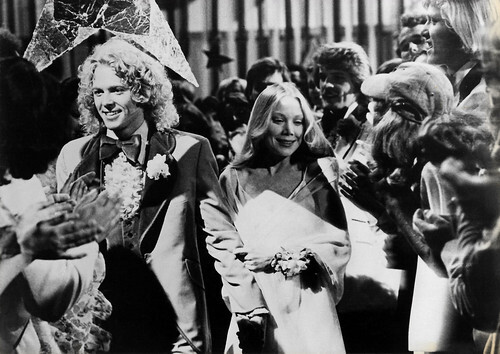
Press photo. Sissy Spacek and William Katt in Carrie (Brian De Palma, 1976).
A young woman sold as a sex slave
Mary Elizabeth ‘Sissy’ Spacek was born in Quitman, Texas, in 1949. She was the daughter of Virginia Frances and Edwin Arnold Spacek Sr., a county agricultural agent. Spacek was nicknamed ‘Sissy’ by her older brothers. She attended Quitman High School and was the homecoming queen.
During her senior year in 1967, she was violently shaken by the death of her 18-year-old brother Robbie from leukaemia. She decided life was way too short to waste it in four years of college and she moved to New York. Spacek began her career as a country singer. Under the name ‘Rainbo’, she recorded the single, ‘John, You Went Too Far This Time’, about John Lennon .
When sales of her music sputtered, Spacek was dropped by her record label. She switched her focus to acting. Spacek worked as a photographic model represented by Ford Models and as an extra at Andy Warhol 's Factory. With the help of her cousin, actor Rip Torn, she was able to enrol at Lee Strasberg's Actors Studio and then at the Lee Strasberg Institute in New York.
In her early career, she often played girls younger than her age. Her first film role was in Prime Cut (Michael Ritchie, 1972), starring Lee Marvin and Gene Hackman in which she played a young woman sold as a sex slave. The film led to a guest role in the television series The Waltons (1973), which she played twice.
The first role in which she was noticed was in Terrence Malick's Neo Noir Badlands (1973). She played Holly, the film's narrator and 15-year-old girlfriend of serial killer Kit (Martin Sheen). Her performance earned her a nomination for the BAFTA Award for Most Promising Newcomer. On the set, she met art director Jack Fisk, whom she would later marry. She worked as the set dresser for Brian De Palma's film Phantom of the Paradise (1974), to assist Fisk, who was the film's production designer.
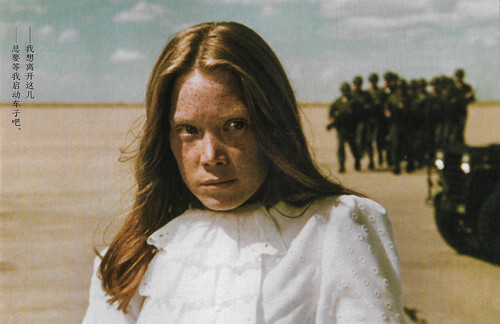
Chinese postcard. Sissy Spacek in Badlands (Terrence Malick, 1973).
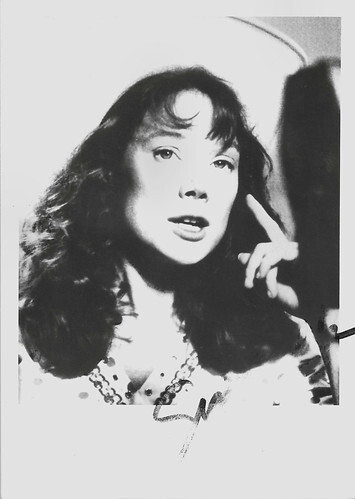
Vintage card with the remains of an autograph.
An unpopular and emotionally confused teenager with telekinetic abilities
Sissy Spacek broke through with the lead role in the supernatural Horror film Carrie (Brian De Palma, 1976). She played an unpopular and emotionally confused teenager with telekinetic abilities. For this role, she received a nomination for the Academy Award for Best Actress, which, however, was not cashed.
She then starred in Robert Altman's psychological drama 3 Women (1977). Spacek helped finance Eraserhead (1977), David Lynch 's directorial debut and is thanked in the film's credits.
She received the Oscar in 1980 for Coal Miner's Daughter (Michael Apted, 1980), in which she played country star Loretta Lynn from the age of about 13 to near middle age and did her own singing. The soundtrack peaked at no. 2 on the Billboard Top Country Albums chart and garnered her a nomination for the Grammy Award for Best Female Country Vocal Performance. Spacek subsequently released her debut studio album, 'Hangin' Up My Heart' (1983).
She received four more Academy Award nominations for her roles in Costa-Gavras's biographical thriller drama Missing (1982) opposite Jack Lemmon , the drama The River (Mark Rydell, 1984) with Mel Gibson , Crimes of the Heart (Bruce Beresford, 1986), and In the Bedroom (Todd Field, 2001). Spacek won a Golden Globe Award for her portrayal of the grieving Ruth Fowler in In the Bedroom. Her other notable films include Raggedy Man (Jack Fisk, 1981), 'Night, Mother (Tom Moore, 1986) opposite Anne Bancroft , JFK (Oliver Stone, 1991), Affliction (Paul Schrader, 1997), The Straight Story (David Lynch, 1999), North Country (Niki Caro, 2005) starring Charlize Theron, and the period drama The Help (Tate Taylor, 2011).
In 2011, Sissy Spacek received a star on the famous Hollywood Walk of Fame. In 2012, she published her memoir, 'My Extraordinary Ordinary Life', with co-author Maryanne Vollers. Spacek married Jack Fisk in 1974 and they had two daughters, Schuyler Elizabeth and Madison Fisk. Schuyler Fisk also acts in films. Spacek lives with her family on a horse ranch near Charlottesville, Virginia. She is an activist for women's rights. Her recent films include The Old Man & the Gun (David Lowery, 2018) starring Robert Redford , and Sam & Kate (Darren Le Gallo, 2022) with Dustin Hoffman .
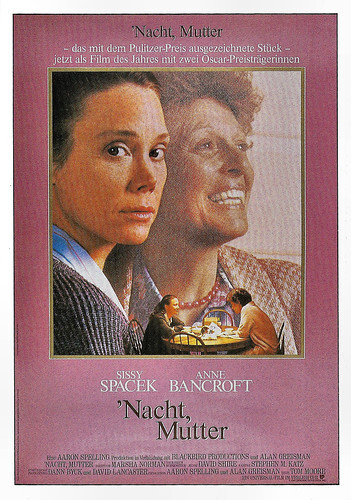
German poster collector card by Cinema. Image: Universal Film. German poster for 'Night, Mother (Tom Moore, 1986), starring Sissy Spacek and Anne Bancroft .
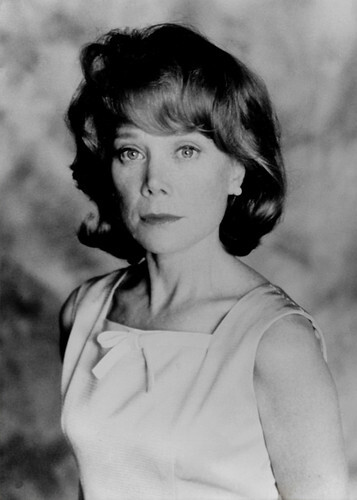
Dutch Press photo by Kippa to promote the TV screening by EO in 1996. Sissy Spacek in A Place for Annie (John Gray, 1994).
Sources: (IMDb), Wikipedia (Dutch and English) and .

Romanian postcard by Casa Filmului Acin, C.P.C.S. Cda 33132.

Press photo. Sissy Spacek and William Katt in Carrie (Brian De Palma, 1976).
A young woman sold as a sex slave
Mary Elizabeth ‘Sissy’ Spacek was born in Quitman, Texas, in 1949. She was the daughter of Virginia Frances and Edwin Arnold Spacek Sr., a county agricultural agent. Spacek was nicknamed ‘Sissy’ by her older brothers. She attended Quitman High School and was the homecoming queen.
During her senior year in 1967, she was violently shaken by the death of her 18-year-old brother Robbie from leukaemia. She decided life was way too short to waste it in four years of college and she moved to New York. Spacek began her career as a country singer. Under the name ‘Rainbo’, she recorded the single, ‘John, You Went Too Far This Time’, about John Lennon .
When sales of her music sputtered, Spacek was dropped by her record label. She switched her focus to acting. Spacek worked as a photographic model represented by Ford Models and as an extra at Andy Warhol 's Factory. With the help of her cousin, actor Rip Torn, she was able to enrol at Lee Strasberg's Actors Studio and then at the Lee Strasberg Institute in New York.
In her early career, she often played girls younger than her age. Her first film role was in Prime Cut (Michael Ritchie, 1972), starring Lee Marvin and Gene Hackman in which she played a young woman sold as a sex slave. The film led to a guest role in the television series The Waltons (1973), which she played twice.
The first role in which she was noticed was in Terrence Malick's Neo Noir Badlands (1973). She played Holly, the film's narrator and 15-year-old girlfriend of serial killer Kit (Martin Sheen). Her performance earned her a nomination for the BAFTA Award for Most Promising Newcomer. On the set, she met art director Jack Fisk, whom she would later marry. She worked as the set dresser for Brian De Palma's film Phantom of the Paradise (1974), to assist Fisk, who was the film's production designer.

Chinese postcard. Sissy Spacek in Badlands (Terrence Malick, 1973).

Vintage card with the remains of an autograph.
An unpopular and emotionally confused teenager with telekinetic abilities
Sissy Spacek broke through with the lead role in the supernatural Horror film Carrie (Brian De Palma, 1976). She played an unpopular and emotionally confused teenager with telekinetic abilities. For this role, she received a nomination for the Academy Award for Best Actress, which, however, was not cashed.
She then starred in Robert Altman's psychological drama 3 Women (1977). Spacek helped finance Eraserhead (1977), David Lynch 's directorial debut and is thanked in the film's credits.
She received the Oscar in 1980 for Coal Miner's Daughter (Michael Apted, 1980), in which she played country star Loretta Lynn from the age of about 13 to near middle age and did her own singing. The soundtrack peaked at no. 2 on the Billboard Top Country Albums chart and garnered her a nomination for the Grammy Award for Best Female Country Vocal Performance. Spacek subsequently released her debut studio album, 'Hangin' Up My Heart' (1983).
She received four more Academy Award nominations for her roles in Costa-Gavras's biographical thriller drama Missing (1982) opposite Jack Lemmon , the drama The River (Mark Rydell, 1984) with Mel Gibson , Crimes of the Heart (Bruce Beresford, 1986), and In the Bedroom (Todd Field, 2001). Spacek won a Golden Globe Award for her portrayal of the grieving Ruth Fowler in In the Bedroom. Her other notable films include Raggedy Man (Jack Fisk, 1981), 'Night, Mother (Tom Moore, 1986) opposite Anne Bancroft , JFK (Oliver Stone, 1991), Affliction (Paul Schrader, 1997), The Straight Story (David Lynch, 1999), North Country (Niki Caro, 2005) starring Charlize Theron, and the period drama The Help (Tate Taylor, 2011).
In 2011, Sissy Spacek received a star on the famous Hollywood Walk of Fame. In 2012, she published her memoir, 'My Extraordinary Ordinary Life', with co-author Maryanne Vollers. Spacek married Jack Fisk in 1974 and they had two daughters, Schuyler Elizabeth and Madison Fisk. Schuyler Fisk also acts in films. Spacek lives with her family on a horse ranch near Charlottesville, Virginia. She is an activist for women's rights. Her recent films include The Old Man & the Gun (David Lowery, 2018) starring Robert Redford , and Sam & Kate (Darren Le Gallo, 2022) with Dustin Hoffman .

German poster collector card by Cinema. Image: Universal Film. German poster for 'Night, Mother (Tom Moore, 1986), starring Sissy Spacek and Anne Bancroft .

Dutch Press photo by Kippa to promote the TV screening by EO in 1996. Sissy Spacek in A Place for Annie (John Gray, 1994).
Sources: (IMDb), Wikipedia (Dutch and English) and .
Published on June 18, 2025 22:00
June 17, 2025
For Lucas: The Many Adventures of Winnie the Pooh (1977)
"How lucky I am to have something that makes saying goodbye so hard", Winnie the Pooh.
On 10 June, my youngest son, Lucas (30), passed away after an epileptic fit and cardiac arrest. Lucas was my angel and my worry child. He was mentally disabled and could not talk, but was, above all, beautiful, cheerful, sweet and left a deep impression on everyone who cared for him. Lucas and I loved watching films together, first a lot of animation films and later nature films. One of the films he loved and wanted to watch over and over again was The Many Adventures of Winnie the Pooh. We watched that brilliant film more than 100 times. As a result, his brother Simon could retell entire dialogues from the film. Even when Lucas's interest in Walt Disney films waned, we continued to sing the Winnie the Pooh theme song during our walks. We also let the song be heard today at the service where we say goodbye to Lucas. Bye-bye, dear Pooh bear of mine.
Paul van Yperen
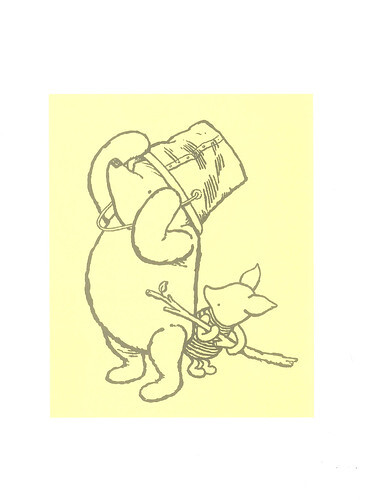
Dutch postcard by Interstat, Amsterdam. Image: A.A. Milne and E.H. Shepard / Disney.
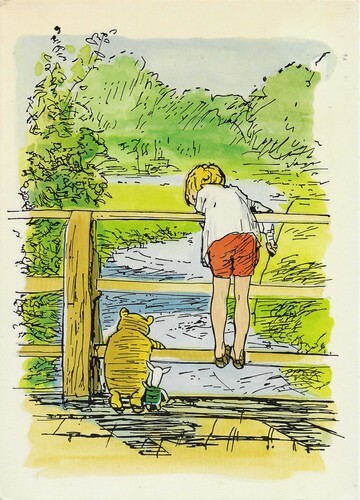
British postcard by Reflex Marketing, Wellingborough, no. PC 107. Illustration: Ernest H. Shepard / Methuen Children's Books, 1983. Postcard sent by mail in the Netherlands in 1989.
The anthology film The Many Adventures of Winnie the Pooh (John Lounsbery, Wolfgang Reitherman, 1977) is Disney's 22nd animated feature, based upon the Winnie-the-Pooh books by A.A. Milne and E.H. Shepard. The film is comprised of three previously released animated Disney featurettes: Winnie the Pooh and the Honey Tree (1966), Winnie the Pooh and the Blustery Day (1968), and Winnie the Pooh and Tigger Too (1974). Extra material was used to link the three featurettes together to allow the stories to merge into each other. The Many Adventures of Winnie the Pooh was first released on a double bill with The Littlest Horse Thieves in 1977.
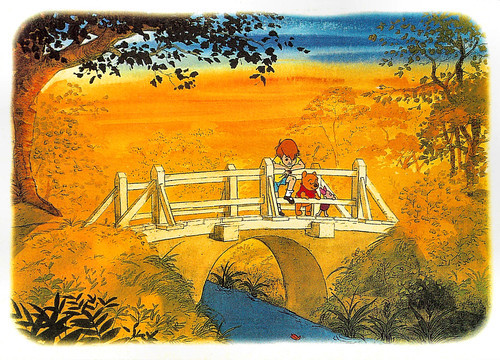
Finnish postcard. Image: Disney. Publicity still for The Many Adventures of Winnie the Pooh (John Lounsbery, Wolfgang Reitherman, 1977). Caption: Greetings from the Hundred Acre Wood!
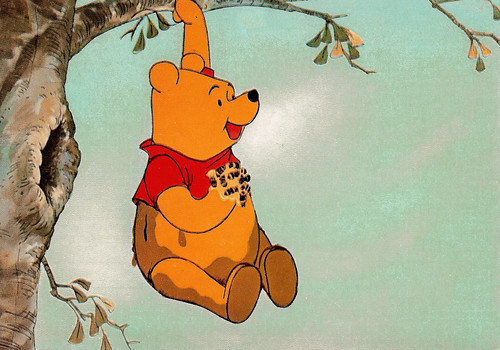
French postcard by Les Presses de Belleville, Paris / LYNA, Paris. Image: Walt Disney Productions, 1965. Publicity still for the short film Winnie the Pooh and the Honey Tree (Wolfgang Reitherman, 1966), later incorporated in the feature The Many Adventures of Winnie the Pooh (John Lounsbery, Wolfgang Reitherman, 1977). Caption: The honey thief.
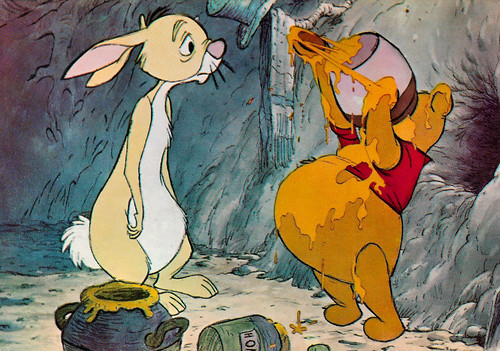
French postcard by Les Presses de Belleville, Paris / LYNA, Paris. Image: Walt Disney Productions, 1965. Publicity still for the short film Winnie the Pooh and the Honey Tree (Wolfgang Reitherman, 1966), later incorporated in the feature The Many Adventures of Winnie the Pooh (John Lounsbery, Wolfgang Reitherman, 1977). Caption: What a gourmand!
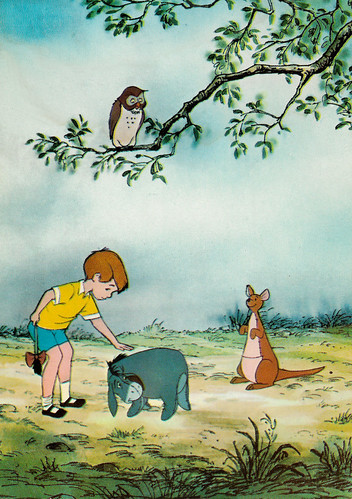
French postcard by Les Presses de Belleville, Paris / LYNA, Paris. Image: Walt Disney Productions, 1965. Publicity still for the short film Winnie the Pooh and the Honey Tree (Wolfgang Reitherman, 1966), later incorporated in the feature The Many Adventures of Winnie the Pooh (John Lounsbery, Wolfgang Reitherman, 1977). Caption: Winnie the Pooh.
The magical world of the Hundred Acre Wood
In Winnie the Pooh and the Honey Tree (Wolfgang Reitherman, 1966), Winnie the Pooh and his friends have adventures in the magical world of the Hundred Acre Wood. The short film is based on the first two chapters of 'Winnie-the-Pooh' by A.A. Milne.
Winnie, Christopher Robin's silly old bear, attempts to get honey from a bee tree. After climbing the tree didn't work, Winnie borrows Christopher Robin's balloon, dunks himself in mud, and floats to the top of the honey tree incognito as a little black rain cloud.
After escaping the angry bees, Pooh decides to get honey the old-fashioned way: getting some from Rabbit, so after stuffing his face with all of Rabbit's honey, Pooh attempts to climb out of Rabbit's front door but becomes stuck!
No matter how hard everyone tries, they can't get him out, so Pooh is stuck for a week until he can lose the excess baggage. Then along comes Gopher, who agrees to help get Pooh out and almost feeds him more honey! But then one morning, Pooh is finally freed from the doorway and ends up in another sticky situation-quite literally!
Winnie the Pooh and the Honey Tree was the last short film produced by Walt Disney, who died of lung cancer on 15 December 1966, ten months after the film's release.
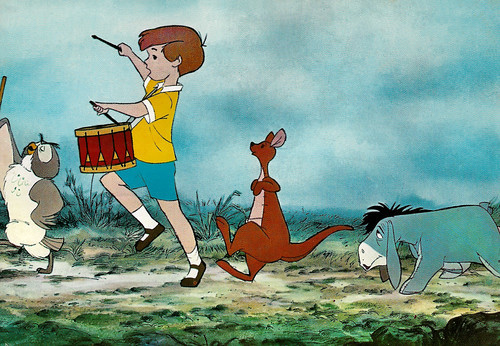
French postcard by Les Presses de Belleville, Paris / LYNA, Paris. Image: Walt Disney Productions, 1965. Publicity still for the short film Winnie the Pooh and the Honey Tree (Wolfgang Reitherman, 1966), later incorporated in the feature The Many Adventures of Winnie the Pooh (John Lounsbery, Wolfgang Reitherman, 1977). Caption: The brass band.

French postcard by Les Presses de Belleville, Paris / LYNA, Paris. Image: Walt Disney Productions, 1965. Publicity still for the short film Winnie the Pooh and the Honey Tree (Wolfgang Reitherman, 1966), later incorporated in the feature The Many Adventures of Winnie the Pooh (John Lounsbery, Wolfgang Reitherman, 1977). Caption: Winnie the Pooh.
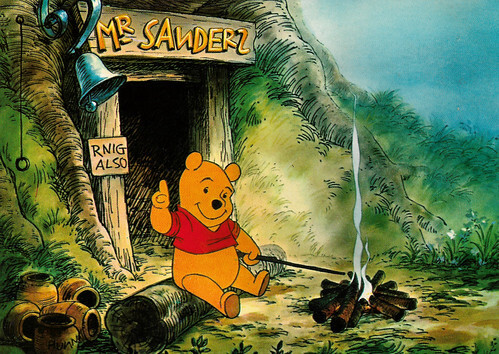
French postcard by Les Presses de Belleville, Paris. Image: Walt Disney Productions, 1965. Publicity still for Winnie the Pooh and the Honey Tree (Wolfgang Reitherman, 1966).
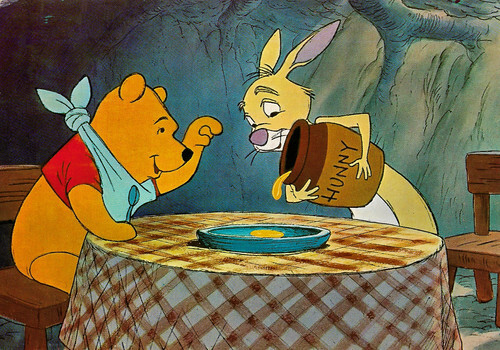
French postcard by Les Presses de Belleville, Paris. Image: Walt Disney Productions, 1965. Publicity still for Winnie the Pooh and the Honey Tree (Wolfgang Reitherman, 1966).
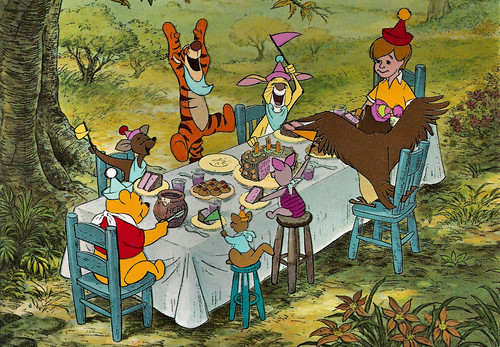
British postcard by J. Arthur Dixon Ltd / Lotus Production, no. PCD/21286. Image: Walt Disney Productions, 1965. Publicity still for the short film Winnie the Pooh and the Blustery Day (Wolfgang Reitherman, 1968), later incorporated in the feature The Many Adventures of Winnie the Pooh (John Lounsbery, Wolfgang Reitherman, 1977). Caption: For deeds well done, Christopher Robin throws a party for heroes Pooh Bear and Piglet and their Hundred Acre Wood friends.
Rumbly in my tumbly
Winnie the Pooh and the Honey Tree (Wolfgang Reitherman, 1966) is the first of the four Winnie the Pooh short films by the Disney studio, based on the A. A. Milne stories. Each character is introduced nicely in this charming short classic. The animation is excellent and the Sherman Brothers composed great songs such as 'Little Black Rain Cloud', 'Up, Down and Touch the Ground', 'Rumbly in My Tumbly' and 'Winnie the Pooh'.
Pooh's determination to get some honey remains amusing. Although he is a bear with very little brain, he's not the sort of bear to give up easily. The honey-loving bear tries various schemes to get his golden delight. It's funny how he often thinks of something, but no matter how hard he tries to think, the only thing that comes to his simple mind is honey.
And it's funny that he does physical exercises, but not for the reasons you could think. Do you think he does physical exercises to get thinner? You'd better think again! He does physical exercises to get hungry, as an excuse to eat honey. Each different character in the film has a unique trait. The donkey Eeyore shows the depressing side of human nature, always finding the downside of anything.
The other characters succeed in cheering him up. The owl is the 'educated' one who loves to hear himself talk. Tigger, happy-go-lucky tiger, bounces around exuberantly on his coil-spring tail, greeting everyone, and sometimes accidentally knocking them over. Winnie the Pooh and the Honey Tree (1966) immediately became a popular phenomenon and led to more Pooh shorts, which later made up the feature film The Many Adventures of Winnie the Pooh (John Lounsbery, Wolfgang Reitherman, 1977).
A fourth, shorter scene was added to bring the film to a close, originally made during the production of Blustery Day. The sequence was based on the final chapter of 'The House at Pooh Corner', where Christopher Robin must leave the Hundred Acre Wood behind as he is starting school. In it, Christopher Robin and Pooh discuss what they liked doing together, and the boy asks his bear to promise to remember him and to keep some of the memories of their time together alive. Pooh agrees to do so, and the film closes with The Narrator (Sebastian Cabot) saying that wherever Christopher Robin goes, Pooh will always be waiting for him whenever he returns.
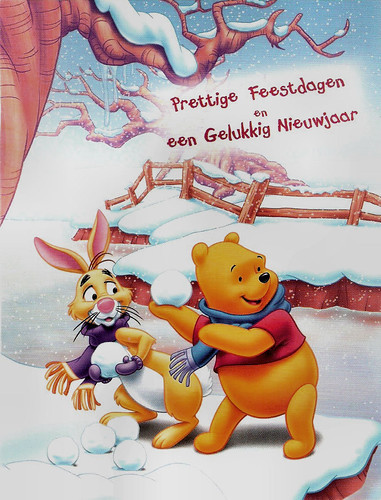
Dutch postcard. Caption: Happy Holidays and Happy New Year.

French postcard by Cartoon Collection, Paris, Réf. 26289. Image: Disney. Based on the "Winnie the Pooh" works by A.A. Milne and E.H. Shepard. Caption: Party.
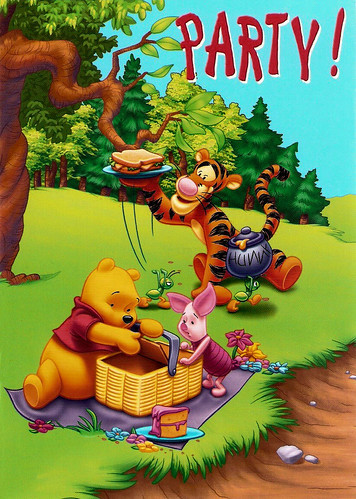
French postcard by Cartoon Collection, Paris, Réf. 24225. Image: Disney. Based on the "Winnie the Pooh" works by A.A. Milne and E.H. Shepard. Caption: Party.
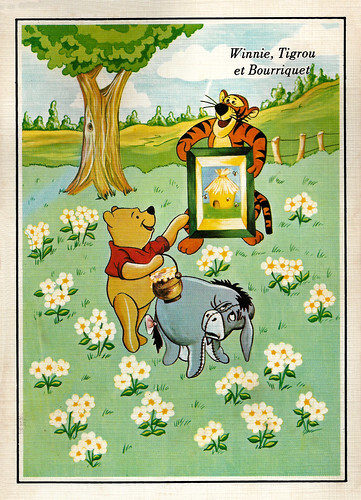
French postcard by MD, Paris, no. D 460. Image: Walt Disney Productions. Caption: Winnie the Pooh, Tiger and Eeyore.
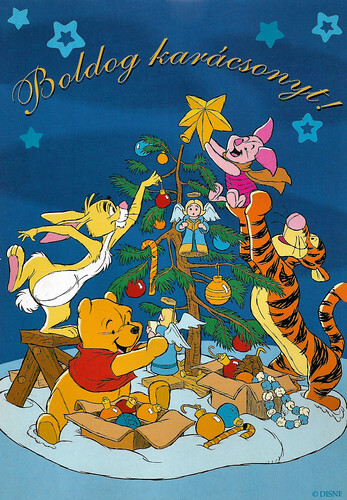
Hungarian postcard. Image: Disney. Caption: Merry Christmas!
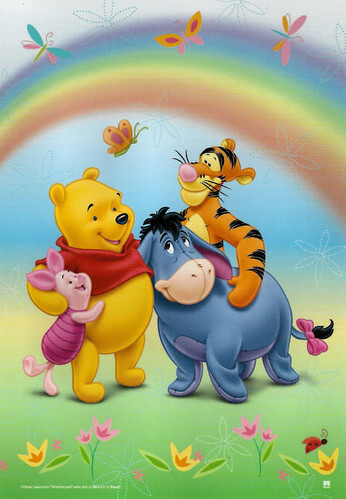
French postcard by Sonis, no. C. 1716. Image: Disney, based on the Winnie the Pooh works by A.A. Milne and E.H. Shepard.
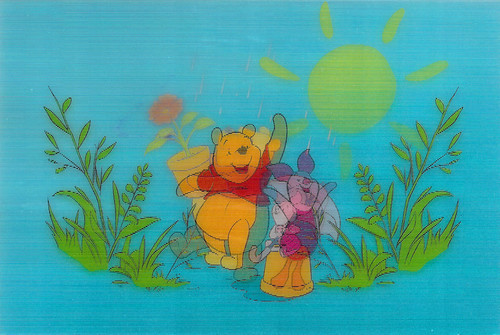
Italian lenticular postcard by Dedit srl, no. 2803474. Image: Disney, based on the "Winnie the Pooh" works by A.A. Milne and E.H. Shepard. Lenticular printing is a technology in which lenticular lenses are used to produce printed images with an illusion of depth, or the ability to change or as for this postcard move as the image is viewed from different angles. Like today, the weather changes on the card from rain to sunshine and back. Sadly, we can't scan the effect.
Sources: Wikipedia and IMDb.
On 10 June, my youngest son, Lucas (30), passed away after an epileptic fit and cardiac arrest. Lucas was my angel and my worry child. He was mentally disabled and could not talk, but was, above all, beautiful, cheerful, sweet and left a deep impression on everyone who cared for him. Lucas and I loved watching films together, first a lot of animation films and later nature films. One of the films he loved and wanted to watch over and over again was The Many Adventures of Winnie the Pooh. We watched that brilliant film more than 100 times. As a result, his brother Simon could retell entire dialogues from the film. Even when Lucas's interest in Walt Disney films waned, we continued to sing the Winnie the Pooh theme song during our walks. We also let the song be heard today at the service where we say goodbye to Lucas. Bye-bye, dear Pooh bear of mine.
Paul van Yperen

Dutch postcard by Interstat, Amsterdam. Image: A.A. Milne and E.H. Shepard / Disney.

British postcard by Reflex Marketing, Wellingborough, no. PC 107. Illustration: Ernest H. Shepard / Methuen Children's Books, 1983. Postcard sent by mail in the Netherlands in 1989.
The anthology film The Many Adventures of Winnie the Pooh (John Lounsbery, Wolfgang Reitherman, 1977) is Disney's 22nd animated feature, based upon the Winnie-the-Pooh books by A.A. Milne and E.H. Shepard. The film is comprised of three previously released animated Disney featurettes: Winnie the Pooh and the Honey Tree (1966), Winnie the Pooh and the Blustery Day (1968), and Winnie the Pooh and Tigger Too (1974). Extra material was used to link the three featurettes together to allow the stories to merge into each other. The Many Adventures of Winnie the Pooh was first released on a double bill with The Littlest Horse Thieves in 1977.

Finnish postcard. Image: Disney. Publicity still for The Many Adventures of Winnie the Pooh (John Lounsbery, Wolfgang Reitherman, 1977). Caption: Greetings from the Hundred Acre Wood!

French postcard by Les Presses de Belleville, Paris / LYNA, Paris. Image: Walt Disney Productions, 1965. Publicity still for the short film Winnie the Pooh and the Honey Tree (Wolfgang Reitherman, 1966), later incorporated in the feature The Many Adventures of Winnie the Pooh (John Lounsbery, Wolfgang Reitherman, 1977). Caption: The honey thief.

French postcard by Les Presses de Belleville, Paris / LYNA, Paris. Image: Walt Disney Productions, 1965. Publicity still for the short film Winnie the Pooh and the Honey Tree (Wolfgang Reitherman, 1966), later incorporated in the feature The Many Adventures of Winnie the Pooh (John Lounsbery, Wolfgang Reitherman, 1977). Caption: What a gourmand!

French postcard by Les Presses de Belleville, Paris / LYNA, Paris. Image: Walt Disney Productions, 1965. Publicity still for the short film Winnie the Pooh and the Honey Tree (Wolfgang Reitherman, 1966), later incorporated in the feature The Many Adventures of Winnie the Pooh (John Lounsbery, Wolfgang Reitherman, 1977). Caption: Winnie the Pooh.
The magical world of the Hundred Acre Wood
In Winnie the Pooh and the Honey Tree (Wolfgang Reitherman, 1966), Winnie the Pooh and his friends have adventures in the magical world of the Hundred Acre Wood. The short film is based on the first two chapters of 'Winnie-the-Pooh' by A.A. Milne.
Winnie, Christopher Robin's silly old bear, attempts to get honey from a bee tree. After climbing the tree didn't work, Winnie borrows Christopher Robin's balloon, dunks himself in mud, and floats to the top of the honey tree incognito as a little black rain cloud.
After escaping the angry bees, Pooh decides to get honey the old-fashioned way: getting some from Rabbit, so after stuffing his face with all of Rabbit's honey, Pooh attempts to climb out of Rabbit's front door but becomes stuck!
No matter how hard everyone tries, they can't get him out, so Pooh is stuck for a week until he can lose the excess baggage. Then along comes Gopher, who agrees to help get Pooh out and almost feeds him more honey! But then one morning, Pooh is finally freed from the doorway and ends up in another sticky situation-quite literally!
Winnie the Pooh and the Honey Tree was the last short film produced by Walt Disney, who died of lung cancer on 15 December 1966, ten months after the film's release.

French postcard by Les Presses de Belleville, Paris / LYNA, Paris. Image: Walt Disney Productions, 1965. Publicity still for the short film Winnie the Pooh and the Honey Tree (Wolfgang Reitherman, 1966), later incorporated in the feature The Many Adventures of Winnie the Pooh (John Lounsbery, Wolfgang Reitherman, 1977). Caption: The brass band.

French postcard by Les Presses de Belleville, Paris / LYNA, Paris. Image: Walt Disney Productions, 1965. Publicity still for the short film Winnie the Pooh and the Honey Tree (Wolfgang Reitherman, 1966), later incorporated in the feature The Many Adventures of Winnie the Pooh (John Lounsbery, Wolfgang Reitherman, 1977). Caption: Winnie the Pooh.

French postcard by Les Presses de Belleville, Paris. Image: Walt Disney Productions, 1965. Publicity still for Winnie the Pooh and the Honey Tree (Wolfgang Reitherman, 1966).

French postcard by Les Presses de Belleville, Paris. Image: Walt Disney Productions, 1965. Publicity still for Winnie the Pooh and the Honey Tree (Wolfgang Reitherman, 1966).

British postcard by J. Arthur Dixon Ltd / Lotus Production, no. PCD/21286. Image: Walt Disney Productions, 1965. Publicity still for the short film Winnie the Pooh and the Blustery Day (Wolfgang Reitherman, 1968), later incorporated in the feature The Many Adventures of Winnie the Pooh (John Lounsbery, Wolfgang Reitherman, 1977). Caption: For deeds well done, Christopher Robin throws a party for heroes Pooh Bear and Piglet and their Hundred Acre Wood friends.
Rumbly in my tumbly
Winnie the Pooh and the Honey Tree (Wolfgang Reitherman, 1966) is the first of the four Winnie the Pooh short films by the Disney studio, based on the A. A. Milne stories. Each character is introduced nicely in this charming short classic. The animation is excellent and the Sherman Brothers composed great songs such as 'Little Black Rain Cloud', 'Up, Down and Touch the Ground', 'Rumbly in My Tumbly' and 'Winnie the Pooh'.
Pooh's determination to get some honey remains amusing. Although he is a bear with very little brain, he's not the sort of bear to give up easily. The honey-loving bear tries various schemes to get his golden delight. It's funny how he often thinks of something, but no matter how hard he tries to think, the only thing that comes to his simple mind is honey.
And it's funny that he does physical exercises, but not for the reasons you could think. Do you think he does physical exercises to get thinner? You'd better think again! He does physical exercises to get hungry, as an excuse to eat honey. Each different character in the film has a unique trait. The donkey Eeyore shows the depressing side of human nature, always finding the downside of anything.
The other characters succeed in cheering him up. The owl is the 'educated' one who loves to hear himself talk. Tigger, happy-go-lucky tiger, bounces around exuberantly on his coil-spring tail, greeting everyone, and sometimes accidentally knocking them over. Winnie the Pooh and the Honey Tree (1966) immediately became a popular phenomenon and led to more Pooh shorts, which later made up the feature film The Many Adventures of Winnie the Pooh (John Lounsbery, Wolfgang Reitherman, 1977).
A fourth, shorter scene was added to bring the film to a close, originally made during the production of Blustery Day. The sequence was based on the final chapter of 'The House at Pooh Corner', where Christopher Robin must leave the Hundred Acre Wood behind as he is starting school. In it, Christopher Robin and Pooh discuss what they liked doing together, and the boy asks his bear to promise to remember him and to keep some of the memories of their time together alive. Pooh agrees to do so, and the film closes with The Narrator (Sebastian Cabot) saying that wherever Christopher Robin goes, Pooh will always be waiting for him whenever he returns.

Dutch postcard. Caption: Happy Holidays and Happy New Year.

French postcard by Cartoon Collection, Paris, Réf. 26289. Image: Disney. Based on the "Winnie the Pooh" works by A.A. Milne and E.H. Shepard. Caption: Party.

French postcard by Cartoon Collection, Paris, Réf. 24225. Image: Disney. Based on the "Winnie the Pooh" works by A.A. Milne and E.H. Shepard. Caption: Party.

French postcard by MD, Paris, no. D 460. Image: Walt Disney Productions. Caption: Winnie the Pooh, Tiger and Eeyore.

Hungarian postcard. Image: Disney. Caption: Merry Christmas!

French postcard by Sonis, no. C. 1716. Image: Disney, based on the Winnie the Pooh works by A.A. Milne and E.H. Shepard.

Italian lenticular postcard by Dedit srl, no. 2803474. Image: Disney, based on the "Winnie the Pooh" works by A.A. Milne and E.H. Shepard. Lenticular printing is a technology in which lenticular lenses are used to produce printed images with an illusion of depth, or the ability to change or as for this postcard move as the image is viewed from different angles. Like today, the weather changes on the card from rain to sunshine and back. Sadly, we can't scan the effect.
Sources: Wikipedia and IMDb.
Published on June 17, 2025 22:00
June 16, 2025
Vladimir Maksimov
Elegant Vladimir Maksimov (1880-1937) was one of the most popular film stars of the Russian empire. After the revolution he became known known for the Soviet films Skorb beskonechnaya / Infinite Sorrow (Aleksandr Panteleyev, 1922), Katsi katsistvis mgelia / Man Is Enemy (Ivane Perestiani, 1923) and Dekabristy / The Decembrists (Aleksandr Ivanovsky, 1927).
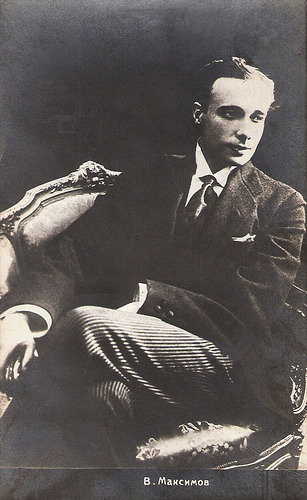
Russian postcard. Sent by mail in Estonia in 1922.
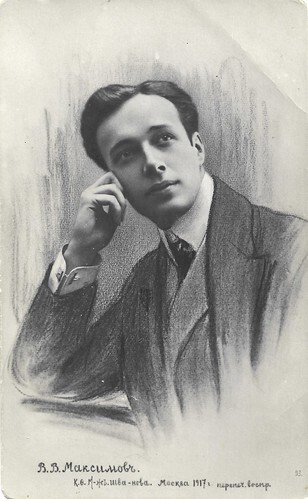
Russian postcard, no. 93, Moscow, 1917. Design by K.F. Shvachunova.
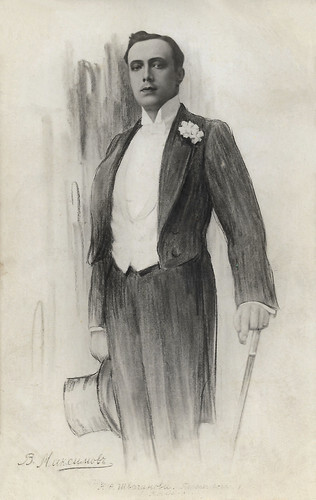
Russian postcard. Design by K.F. Shvachunova.
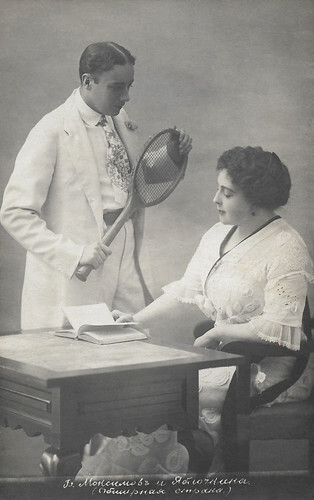
Russian postcard. Vladimir Maksimov and Yablochkina in the stage play 'Общирная страна' (A vast country). 'Обширная страна' was staged in the Imperial Moscow Theatre (Malyi Theatre) in the season of 1912-1913. It was based on Arthur Schnitzler's play 'Das weite Land'. Maksimov played the role of Otto.
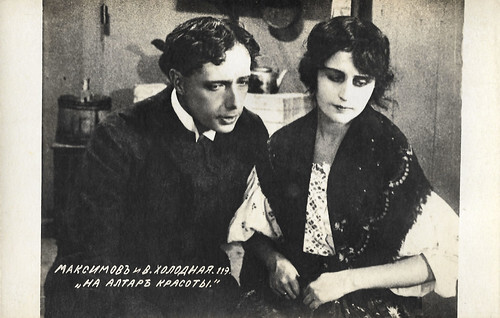
Russian postcard. Vladimir Maksimov and Vera Kholodnaya in Na altar krasoty / To the Altar of Beauty (Pyotr Chardynin, 1917).
At midnight in the graveyard
Vladimir Vasilievich Maksimov (Russian: Владимир Васильевич Максимов) was born in Moscow in the Russian Empire in 1880. His mother was a singing teacher.
Maksimov started his stage career in 1904 at the Moscow Art Theatre under the direction of Konstantin Stanislavsky and V. Nemirovich-Danchenko. Among his roles was Konstantin in The Seagull by Anton Chekhov. From 1906 to 1918, he performed at the famous Maly Theatre.
In 1910, he made his film debut opposite Ivan Mozzhukin for the Khanzhonkov production company in V polnoch na kladbishche/At Midnight in the Graveyard (Vasily Goncharov, 1910). In this short silent horror film, two men are betting about who is to visit a Paris cemetery at midnight. The visit turns out to be fatal.
Next, he played for Khanzhonkov in Oborona Sevastopolya / Defence of Sebastopol (Vasili Goncharov, Aleksandr Khanzhonkov, 1911), the first film ever shot by two cameras. Set in 1854-1855, in Sebastopol and Yalta during the Crimean War. Admirals Kornilov ( Ivan Mozzhukin ) and Nakhimov (Andrej Gromov) organise the defence during the siege of Sebastopol. Both admirals are killed during the battle, and the city of Sebastopol is taken by the alliance of British, French, Sardinian, and Turkish troops.
The legendary feat of Sailor Koshka (N. Semyonov) was staged at the original location. Veterans of the Crimean War of 1854-1855 took part in the film production. With 100 minutes, it was Russia's first full-length feature film. Oborona Sevastopolya/Defence of Sebastopol premiered in 1911 at the Livadia in Yalta, a palace for Tsar Nicholas II, who was the main sponsor of this production.
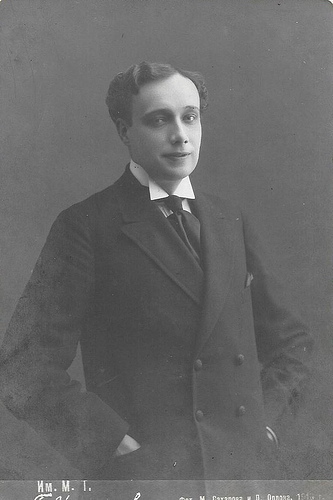
Russian postcard. Collection: Didier Hanson.
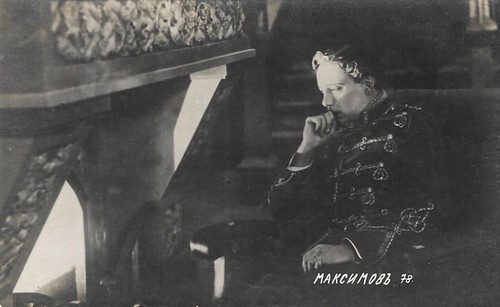
Russian postcard, no. 78. Collection: Didier Hanson.
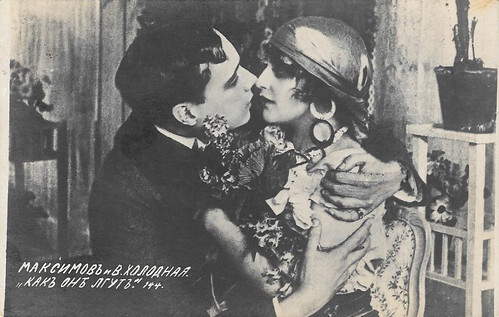
Russian postcard, no. 144. Collection: Didier Hanson. Vera Kholodnaya and Vladimir Maksimov in Kak oni lgut/How they lie (Vyacheslav Viskovsky, 1917).
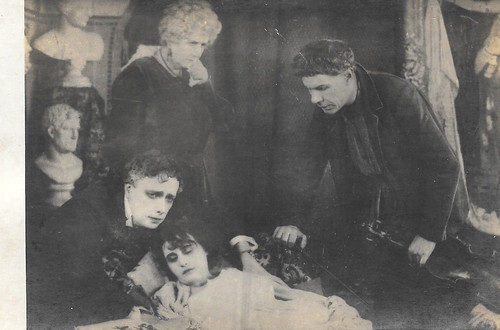
Russian postcard. Collection: Didier Hanson. This is probably the final scene of Molchi, grust'... molchi / Still, Sadness... Still... (Pyotr Chardynin, Kharitonov, 1917). The card depicts the final scene where Paola ( Vera Kholodnaya ) dies, which the Russian press compared to the death of Trilby. She is surrounded on the right by her partner, the musical clown Lorio (Pyotr Chardynin), and by her lover, the painter Volyntsev (Vladimir Maksimov), on the left. In the back, the painter's mother (Olga Rakhmanova). The statues refer to the artist's studio. Only the first part of this film survives. At the time, it was a huge success in Russia.
The elegantly dressed, romantic lover
Till the end of World War I, Vladimir Maksimov starred in many silent films, including the drama Anfisa (Yakov Protazanov, 1912), the German film Das Haus ohne Tür / The House without a Door (Stellan Rye, 1914) with Theodoor Loos , and Peterburgskiye trushchobi / Petersburg Slums (Petr Cardynin a.k.a. Pyotr Chardynin, Vladimir Gardin, Yakov Protazanov, 1915).
Often playing the elegantly dressed, romantic lover, Maksimov became one of the most popular Russian actors of his era. In 1915 and 1917, he also directed some films.
Maksimov was one of the stars in the cast of the silent drama Molchi, grust... molchi/Молчи, грусть...молчи / Be silent, sorrow ... be silent (Petr Cardynin a.k.a. Pyotr Chardynin, 1918) as Volyntsev, an artist, opposite Vera Kholodnaya , Ossip Runitsch and Vitold Polonsky . This film consisted of two parts, but only the first part (44 minutes in length) survives.
After the Russian Revolution, Maksimov appeared in Soviet films like Skorb beskonechnaya / Infinite Sorrow (Aleksandr Panteleyev, 1922), Katsi katsistvis mgelia / Man Is Enemy (Ivane Perestiani, 1923) as Kraev, Slesar i kantsler / Locksmith and Chancellor (Vladimir Gardin, 1923) as the lawyer Frank Frey. His last part was as Alexander in Dekabristy / The Decembrists (Aleksandr Ivanovsky, 1927). From 1919 to 1924, he was also one of the organisers of the Bolshoi Drama Theatre.
From 1924 on, he taught at the Leningrad Institute of Performing Arts. In 1925, the Soviet Union honoured him as 'Artist of the State'. Vladimir Maksimov died in 1937 in Moscow, Soviet Union. He was 56.
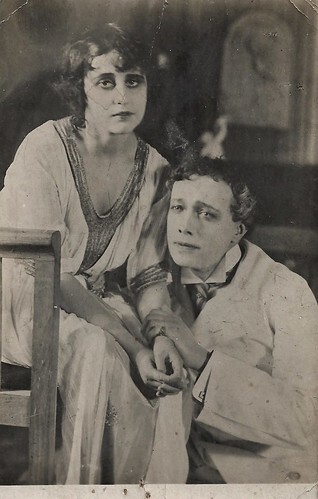
Russian-Polish postcard by K Ltd, dated 5-11-1918. Vladimir Maksimov and Vera Kholodnaya in Сказка любви дорогой/Молчи, грусть... молчи / Be Silent, My Sorrow, Be Silent (Piotr Chardynin, 1918).
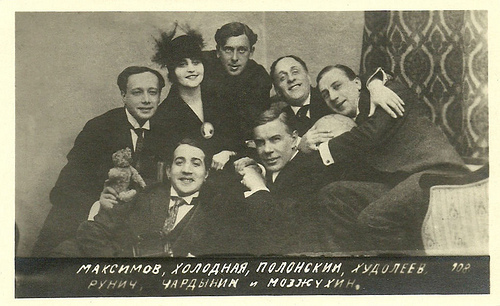
Russian postcard, no. 108. Collection: Didier Hanson. A Who is Who of the Russian silent cinema. In a circle from left: actor Vladimir Maksimov (with bear), actress Vera Kholodnaya , actor Vitold Polonsky , actor Ivan Khudoleyev, actor Ivan Mozzhukin , actor-director Pyotr Cardynin and actor Ossip Runitsch .
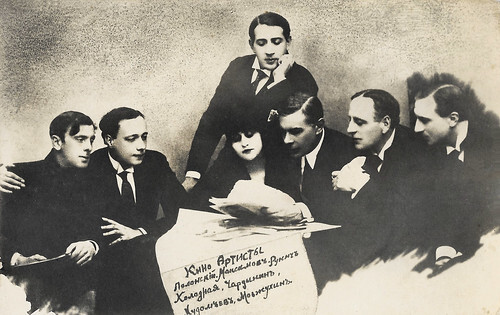
Russian postcard. Collection: Didier Hanson. A Who is Who of the Russian silent cinema. From left to right: Vitold Polonsky , Vladimir Maksimov, Vera Kholodnaya , Ossip Runitsch (in the back), Pyotr Cardynin, Ivan Khudoleyev, and Ivan Mozzhukin .
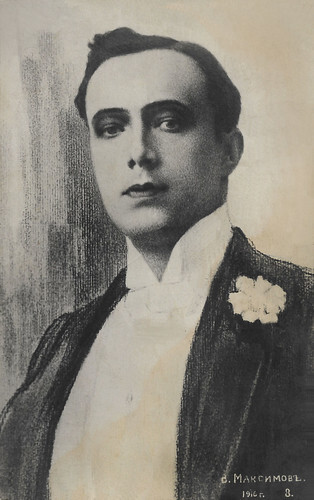
Russian postcard, no. 8, 1916. Design possibly by K.F. Shvachunova.
Source: Yuri Tsivian (Silent Witnesses: Russian Films 1908-1919), Wikipedia (French, Russian and English), and .

Russian postcard. Sent by mail in Estonia in 1922.

Russian postcard, no. 93, Moscow, 1917. Design by K.F. Shvachunova.

Russian postcard. Design by K.F. Shvachunova.

Russian postcard. Vladimir Maksimov and Yablochkina in the stage play 'Общирная страна' (A vast country). 'Обширная страна' was staged in the Imperial Moscow Theatre (Malyi Theatre) in the season of 1912-1913. It was based on Arthur Schnitzler's play 'Das weite Land'. Maksimov played the role of Otto.

Russian postcard. Vladimir Maksimov and Vera Kholodnaya in Na altar krasoty / To the Altar of Beauty (Pyotr Chardynin, 1917).
At midnight in the graveyard
Vladimir Vasilievich Maksimov (Russian: Владимир Васильевич Максимов) was born in Moscow in the Russian Empire in 1880. His mother was a singing teacher.
Maksimov started his stage career in 1904 at the Moscow Art Theatre under the direction of Konstantin Stanislavsky and V. Nemirovich-Danchenko. Among his roles was Konstantin in The Seagull by Anton Chekhov. From 1906 to 1918, he performed at the famous Maly Theatre.
In 1910, he made his film debut opposite Ivan Mozzhukin for the Khanzhonkov production company in V polnoch na kladbishche/At Midnight in the Graveyard (Vasily Goncharov, 1910). In this short silent horror film, two men are betting about who is to visit a Paris cemetery at midnight. The visit turns out to be fatal.
Next, he played for Khanzhonkov in Oborona Sevastopolya / Defence of Sebastopol (Vasili Goncharov, Aleksandr Khanzhonkov, 1911), the first film ever shot by two cameras. Set in 1854-1855, in Sebastopol and Yalta during the Crimean War. Admirals Kornilov ( Ivan Mozzhukin ) and Nakhimov (Andrej Gromov) organise the defence during the siege of Sebastopol. Both admirals are killed during the battle, and the city of Sebastopol is taken by the alliance of British, French, Sardinian, and Turkish troops.
The legendary feat of Sailor Koshka (N. Semyonov) was staged at the original location. Veterans of the Crimean War of 1854-1855 took part in the film production. With 100 minutes, it was Russia's first full-length feature film. Oborona Sevastopolya/Defence of Sebastopol premiered in 1911 at the Livadia in Yalta, a palace for Tsar Nicholas II, who was the main sponsor of this production.

Russian postcard. Collection: Didier Hanson.

Russian postcard, no. 78. Collection: Didier Hanson.

Russian postcard, no. 144. Collection: Didier Hanson. Vera Kholodnaya and Vladimir Maksimov in Kak oni lgut/How they lie (Vyacheslav Viskovsky, 1917).

Russian postcard. Collection: Didier Hanson. This is probably the final scene of Molchi, grust'... molchi / Still, Sadness... Still... (Pyotr Chardynin, Kharitonov, 1917). The card depicts the final scene where Paola ( Vera Kholodnaya ) dies, which the Russian press compared to the death of Trilby. She is surrounded on the right by her partner, the musical clown Lorio (Pyotr Chardynin), and by her lover, the painter Volyntsev (Vladimir Maksimov), on the left. In the back, the painter's mother (Olga Rakhmanova). The statues refer to the artist's studio. Only the first part of this film survives. At the time, it was a huge success in Russia.
The elegantly dressed, romantic lover
Till the end of World War I, Vladimir Maksimov starred in many silent films, including the drama Anfisa (Yakov Protazanov, 1912), the German film Das Haus ohne Tür / The House without a Door (Stellan Rye, 1914) with Theodoor Loos , and Peterburgskiye trushchobi / Petersburg Slums (Petr Cardynin a.k.a. Pyotr Chardynin, Vladimir Gardin, Yakov Protazanov, 1915).
Often playing the elegantly dressed, romantic lover, Maksimov became one of the most popular Russian actors of his era. In 1915 and 1917, he also directed some films.
Maksimov was one of the stars in the cast of the silent drama Molchi, grust... molchi/Молчи, грусть...молчи / Be silent, sorrow ... be silent (Petr Cardynin a.k.a. Pyotr Chardynin, 1918) as Volyntsev, an artist, opposite Vera Kholodnaya , Ossip Runitsch and Vitold Polonsky . This film consisted of two parts, but only the first part (44 minutes in length) survives.
After the Russian Revolution, Maksimov appeared in Soviet films like Skorb beskonechnaya / Infinite Sorrow (Aleksandr Panteleyev, 1922), Katsi katsistvis mgelia / Man Is Enemy (Ivane Perestiani, 1923) as Kraev, Slesar i kantsler / Locksmith and Chancellor (Vladimir Gardin, 1923) as the lawyer Frank Frey. His last part was as Alexander in Dekabristy / The Decembrists (Aleksandr Ivanovsky, 1927). From 1919 to 1924, he was also one of the organisers of the Bolshoi Drama Theatre.
From 1924 on, he taught at the Leningrad Institute of Performing Arts. In 1925, the Soviet Union honoured him as 'Artist of the State'. Vladimir Maksimov died in 1937 in Moscow, Soviet Union. He was 56.

Russian-Polish postcard by K Ltd, dated 5-11-1918. Vladimir Maksimov and Vera Kholodnaya in Сказка любви дорогой/Молчи, грусть... молчи / Be Silent, My Sorrow, Be Silent (Piotr Chardynin, 1918).

Russian postcard, no. 108. Collection: Didier Hanson. A Who is Who of the Russian silent cinema. In a circle from left: actor Vladimir Maksimov (with bear), actress Vera Kholodnaya , actor Vitold Polonsky , actor Ivan Khudoleyev, actor Ivan Mozzhukin , actor-director Pyotr Cardynin and actor Ossip Runitsch .

Russian postcard. Collection: Didier Hanson. A Who is Who of the Russian silent cinema. From left to right: Vitold Polonsky , Vladimir Maksimov, Vera Kholodnaya , Ossip Runitsch (in the back), Pyotr Cardynin, Ivan Khudoleyev, and Ivan Mozzhukin .

Russian postcard, no. 8, 1916. Design possibly by K.F. Shvachunova.
Source: Yuri Tsivian (Silent Witnesses: Russian Films 1908-1919), Wikipedia (French, Russian and English), and .
Published on June 16, 2025 22:00
June 15, 2025
Photo by Lizzie Caswall Smith
Lizzie Caswall Smith (1870–1958) was an early 20th-century British photographer who specialised in society and celebrity studio portraits. She was associated with the Women's Suffrage movement and photographed many suffragettes. She also photographed prominent British actors including Henry Ainley, Johnston Forbes-Robertson, Basil Gill, Billie Burke, and Gertrude Elliott, which were often used for postcards. We chose 15 of these postcards for this post.
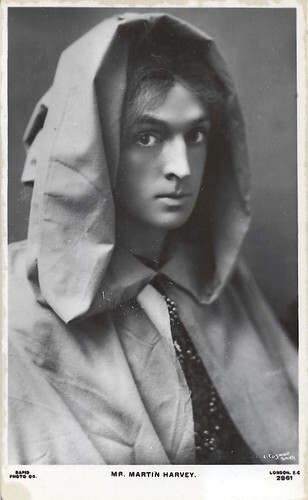
British postcard by Rapid Photo Co., London, no. 2961. Photo: Lizzie Caswall Smith, 1911. John Martin Harvey as Pelleas in Maurice Maeterlinck's stage play 'Pelleas and Melisande' (1893, Pelléas et Mélisande).
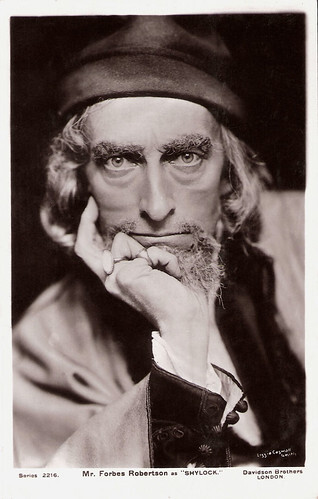
British postcard in the Real Photographic Series by Davidson Brothers, London, no. 2216. Photo: Lizzie Caswall-Smith. Caption: Mr. Forbes Robertson as 'Shylock'. Sent by mail in 1908.
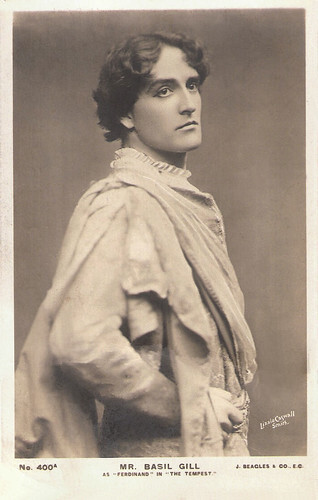
British postcard by Beagles & Co, London, no. 400A. Photo: Lizzie Caswall Smith. Basil Gill as Ferdinand in 'The Tempest' by William Shakespeare.
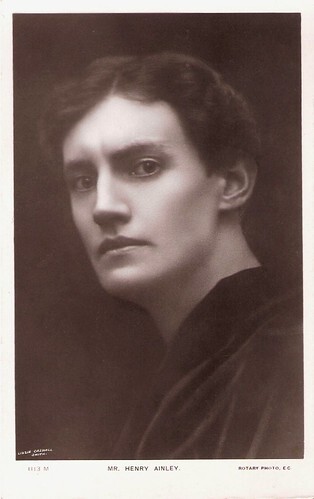
British postcard by Rotary Photo, no. 1113 M. Photo: Lizzie Caswall Smith. Henry Ainley .
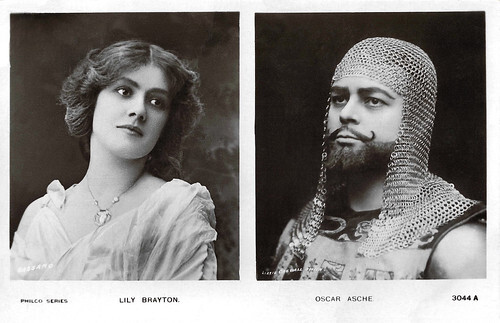
British postcard in the Philco Series, no. 3044 A. Photos: Bassano (left) and Lizzie Caswall Smith (right). Left: Lily Brayton. Right: Oscar Asche as Bolingbroke in 'Richard II' by William Shakespeare.
The last photo of Florence Nightingale
Lizzie Caswall Smith was born in 1870. She first exhibited at the Royal Photographic Society in 1902 and then again in 1913.
She had a photographer brother, John Caswall Smith. Lizzie probably learned photography from him. When he died in 1902, she inherited his photo studio at 305 Oxford Street. She operated the Gainsborough Studio at 309 Oxford Street from 1907 until 1920. Then she moved to 90 Great Russell Street where she stayed until her retirement in 1930, aged 60.
Smith was a supporter of the suffrage movement and photographed many suffragettes including Christabel Pankhurst, Millicent Fawcett and Flora Drummond, images that were then made into postcards. Many Edwardian stage performers such as Lily Elsie, Billie Burke , Gertrude Elliott and the renowned 'Gibson Girl' Camille Clifford were photographed by Smith.
Her sepia-toned platinotype copies of photographs of Peter Llewelyn Davies and J. M. Barrie are in the collection of the National Portrait Gallery. On 19 November 2008, a rare black-and-white photograph of Florence Nightingale taken in 1910 by Lizzie Caswall Smith was auctioned by Dreweatts auction house in Newbury, Berkshire, England, for £5,500. On the back of the photograph Caswall Smith had noted in pencil "Florence Nightingale taken just before she died, House nr Park Lane (London). The only photograph I ever took out of studio – I shall never forget the experience."
Lizzie Caswall Smith died in Ealing, London, in 1958. She was 88.
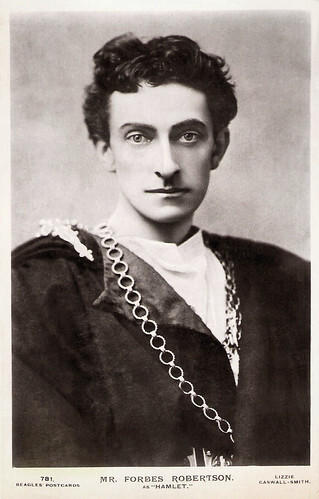
British postcard by Beagles Photocards, no. 781. Photo: Lizzie Caswall-Smith. Caption: Mr. Forbes Robertson as Hamlet. Sent by mail in 1913.
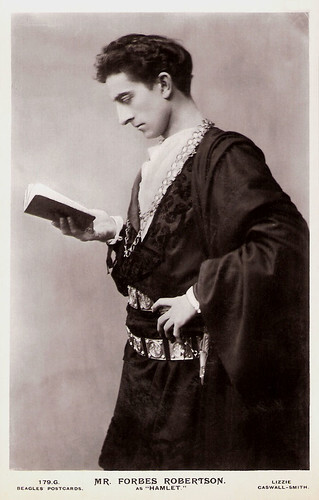
British postcard by Beagles' Postcards, no. 179 G. Photo: Lizzie Caswall-Smith. Caption: Johnston Forbes-Robertson as Hamlet.
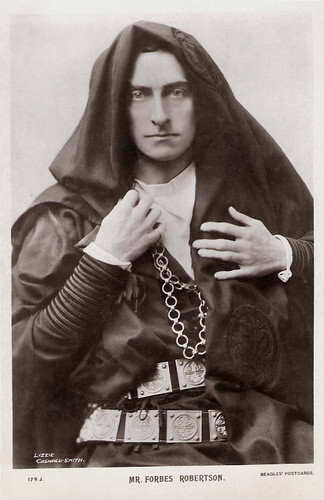
British postcard by Beagles Photocards, no. 179 J. Photo: Lizzie Caswall-Smith. Mr. Forbes Robertson . Publicity still for a stage production of Hamlet by William Shakespeare.
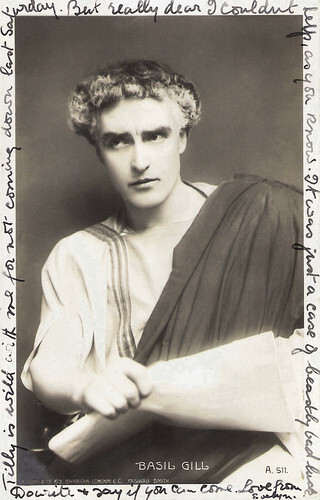
British postcard by H. Dunn & Co, London, no. A. 511. Photo: Caswall Smith. Basil Gill .
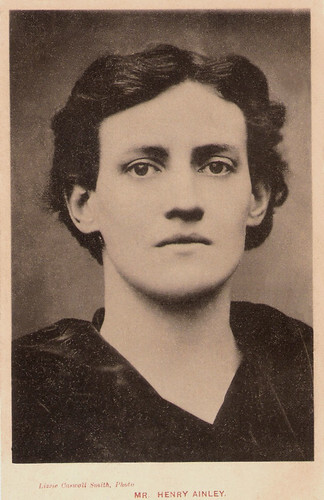
British postcard in the Stageland Series by Davidson Bros.' Pictorial Post Cards, no. 6077. Photo: Lizzie Caswall Smith. Henry Ainley .
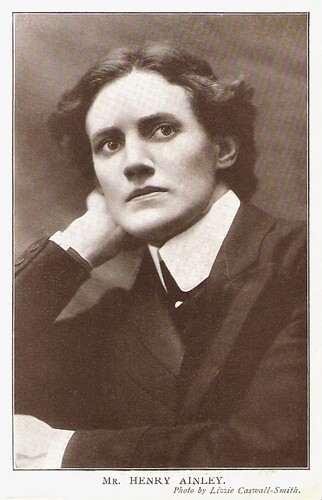
British postcard in the My Queen & Romance Series. Photo: Lizzie Caswall-Smith. Henry Ainley .
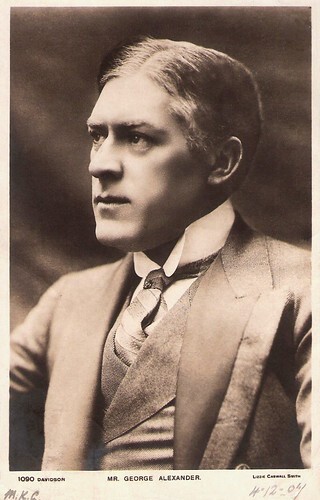
British postcard in the Real Photo series by Davidson Bros, no. 1090. Photo: Lizzie Caswall Smith. George Alexander . Sent by mail in 1907.
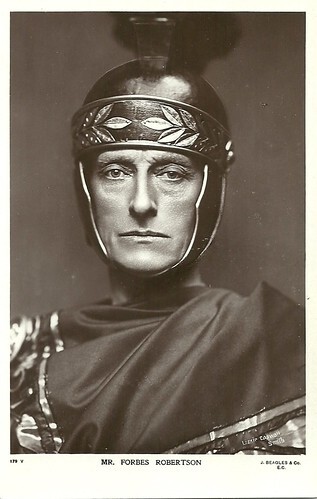
British postcard b J. Beagles & Co., London, 179 V. Photo Lizzie Caswall Smith. Mr. Forbes-Robertson as Julius Caesar in G.B. Shaw's play 'Caesar and Cleopatra' (1899).
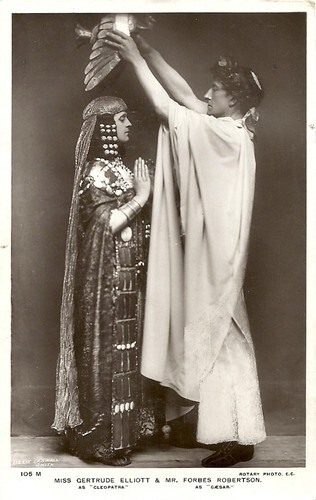
British postcard by Rotary Photo, E.C., no. 105 M. Photo: Lizzie Caswall Smith. Johnston Forbes-Robertson and Gertrude Elliott in the title roles of G.B. Shaw's play 'Caesar and Cleopatra' (1899).
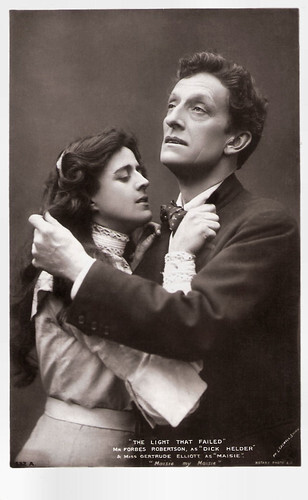
British postcard in the Rotary Photographic Series, no. 1632 A. Photo: Lizzie Caswall-Smith. Publicity still for a stage production of 'The Light That Failed' (1903). Caption: Mr. Forbes Robertson as Dick Helder (sic), Gertrude Elliott as Maisie, "Maisie, my Maisie".
Sources: Truth in Photography, Wikipedia (English and French) and National Portrait Gallery.

British postcard by Rapid Photo Co., London, no. 2961. Photo: Lizzie Caswall Smith, 1911. John Martin Harvey as Pelleas in Maurice Maeterlinck's stage play 'Pelleas and Melisande' (1893, Pelléas et Mélisande).

British postcard in the Real Photographic Series by Davidson Brothers, London, no. 2216. Photo: Lizzie Caswall-Smith. Caption: Mr. Forbes Robertson as 'Shylock'. Sent by mail in 1908.

British postcard by Beagles & Co, London, no. 400A. Photo: Lizzie Caswall Smith. Basil Gill as Ferdinand in 'The Tempest' by William Shakespeare.

British postcard by Rotary Photo, no. 1113 M. Photo: Lizzie Caswall Smith. Henry Ainley .

British postcard in the Philco Series, no. 3044 A. Photos: Bassano (left) and Lizzie Caswall Smith (right). Left: Lily Brayton. Right: Oscar Asche as Bolingbroke in 'Richard II' by William Shakespeare.
The last photo of Florence Nightingale
Lizzie Caswall Smith was born in 1870. She first exhibited at the Royal Photographic Society in 1902 and then again in 1913.
She had a photographer brother, John Caswall Smith. Lizzie probably learned photography from him. When he died in 1902, she inherited his photo studio at 305 Oxford Street. She operated the Gainsborough Studio at 309 Oxford Street from 1907 until 1920. Then she moved to 90 Great Russell Street where she stayed until her retirement in 1930, aged 60.
Smith was a supporter of the suffrage movement and photographed many suffragettes including Christabel Pankhurst, Millicent Fawcett and Flora Drummond, images that were then made into postcards. Many Edwardian stage performers such as Lily Elsie, Billie Burke , Gertrude Elliott and the renowned 'Gibson Girl' Camille Clifford were photographed by Smith.
Her sepia-toned platinotype copies of photographs of Peter Llewelyn Davies and J. M. Barrie are in the collection of the National Portrait Gallery. On 19 November 2008, a rare black-and-white photograph of Florence Nightingale taken in 1910 by Lizzie Caswall Smith was auctioned by Dreweatts auction house in Newbury, Berkshire, England, for £5,500. On the back of the photograph Caswall Smith had noted in pencil "Florence Nightingale taken just before she died, House nr Park Lane (London). The only photograph I ever took out of studio – I shall never forget the experience."
Lizzie Caswall Smith died in Ealing, London, in 1958. She was 88.

British postcard by Beagles Photocards, no. 781. Photo: Lizzie Caswall-Smith. Caption: Mr. Forbes Robertson as Hamlet. Sent by mail in 1913.

British postcard by Beagles' Postcards, no. 179 G. Photo: Lizzie Caswall-Smith. Caption: Johnston Forbes-Robertson as Hamlet.

British postcard by Beagles Photocards, no. 179 J. Photo: Lizzie Caswall-Smith. Mr. Forbes Robertson . Publicity still for a stage production of Hamlet by William Shakespeare.

British postcard by H. Dunn & Co, London, no. A. 511. Photo: Caswall Smith. Basil Gill .

British postcard in the Stageland Series by Davidson Bros.' Pictorial Post Cards, no. 6077. Photo: Lizzie Caswall Smith. Henry Ainley .

British postcard in the My Queen & Romance Series. Photo: Lizzie Caswall-Smith. Henry Ainley .

British postcard in the Real Photo series by Davidson Bros, no. 1090. Photo: Lizzie Caswall Smith. George Alexander . Sent by mail in 1907.

British postcard b J. Beagles & Co., London, 179 V. Photo Lizzie Caswall Smith. Mr. Forbes-Robertson as Julius Caesar in G.B. Shaw's play 'Caesar and Cleopatra' (1899).

British postcard by Rotary Photo, E.C., no. 105 M. Photo: Lizzie Caswall Smith. Johnston Forbes-Robertson and Gertrude Elliott in the title roles of G.B. Shaw's play 'Caesar and Cleopatra' (1899).

British postcard in the Rotary Photographic Series, no. 1632 A. Photo: Lizzie Caswall-Smith. Publicity still for a stage production of 'The Light That Failed' (1903). Caption: Mr. Forbes Robertson as Dick Helder (sic), Gertrude Elliott as Maisie, "Maisie, my Maisie".
Sources: Truth in Photography, Wikipedia (English and French) and National Portrait Gallery.
Published on June 15, 2025 22:00
June 14, 2025
15 postcards from GDI: Dutch postcards of the late 1940s
In our monthly post on the postcard collection of the Geoffrey Donaldson Institute (GDI), we again chose 15 postcards from a big album from the estate of film historians Tjitte de Vries and Ati Mul. It's an album which they probably started somewhere in the 1970s with interesting postcards from several periods and several countries. For this post, we selected 15 Dutch postcards from the late 1940s with Hollywood stars. After years of hardship and watching merely Nazi films, the Netherlands could watch a reservoir of American films from previous years. Filmgoers revelled in the beauty and glamour of Tinseltown.
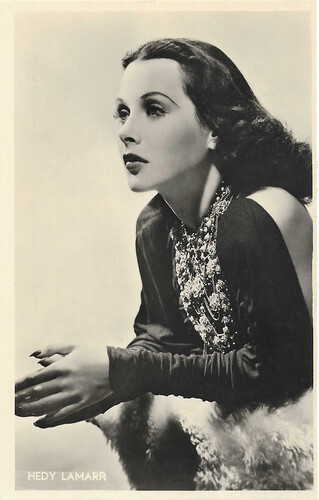
Dutch postcard by J.S.A. Photo: Laszlo Willinger / M.G.M. / M.P.E.
Glamorous and seductive film star Hedy Lamarr (1913–2000) was born in Austria. The notorious Czechoslovak film Ekstase/Ecstasy (1933) made her an international sensation, and Louis Mayer invited her to Hollywood, where she became ‘the most beautiful woman in films’.
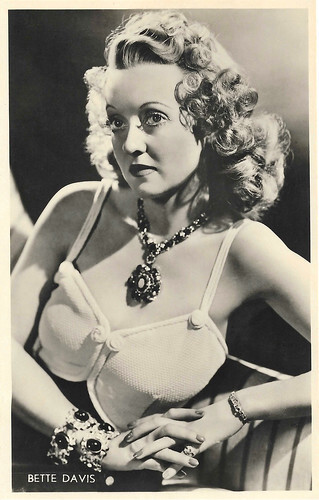
Dutch postcard by J.S.A. Photo: Warner / M.P.E.
American film star Bette Davis (1908-1989) was one of the greatest actors in world cinema history. She dared to play unsympathetic, sardonic characters and was reputed for her performances in a range of film genres, from contemporary crime melodramas to historical and period films and occasional comedies. Her greatest successes were her roles in romantic dramas.
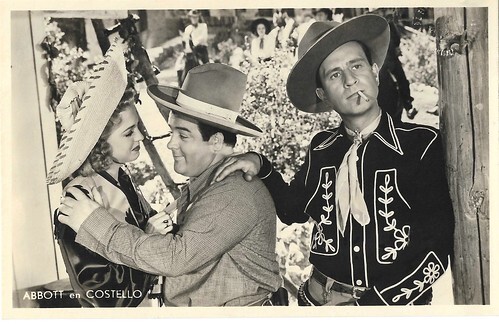
Dutch postcard by J.S.A. Photo: F.B.O. / M.P.E. Abbott and Costello in Ride 'Em Cowboy (Arthur Lubin, 1942).
William 'Bud' Abbott (1895–1974) and Lou Costello (1906–1959) were an American comedy duo that first worked together in 1935. Their work in vaudeville and on stage, radio, film and television made them the most popular comedy team during the 1940s and early 1950s.
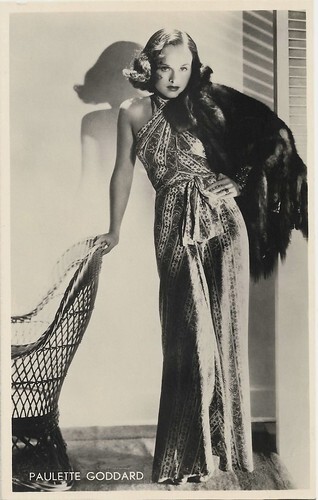
Dutch postcard by S. & v.H., A. Photo: M.P.E.A.
American actress Paulette Goddard (1905-1990) started her career as a fashion model and as a Ziegfeld Girl in several Broadway shows. In the 1940s, she became a major star at Paramount Pictures. She was Charlie Chaplin's leading lady in Modern Times (1936) and The Great Dictator. Goddard was nominated for an Oscar for Best Supporting Actress for So Proudly We Hail! (1943). Her husbands included Chaplin, Burgess Meredith, and Erich Maria Remarque.
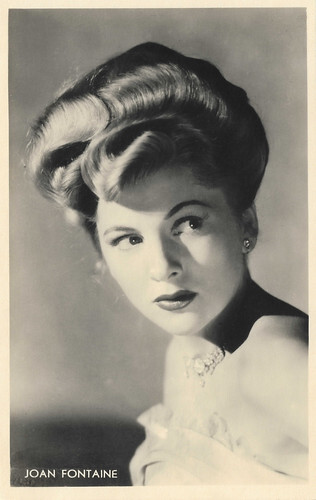
Dutch postcard by S. & v. H., A. Photo: M.P.E.A.
American actress Joan Fontaine (1917-2013) was the younger sister of Hollywood star Olivia de Havilland, but Joan made a name for herself with two classics by Alfred Hitchcock, Rebecca (1941) and Suspicion (1942). For the first she was nominated for the Oscar and for the second she won the award.
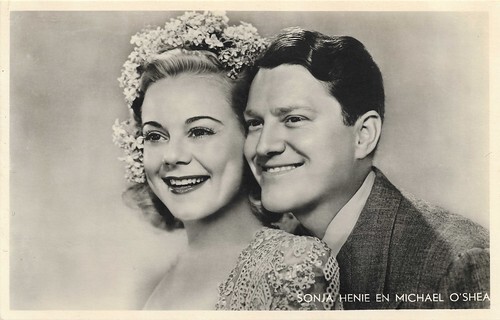
Dutch postcard by S. & v. H., A. Photo: M.P.E.A. Sonja Henie and Michael O'Shea in It's a Pleasure (William A. Seiter, 1945).
Petite and glamorous Sonja Henie (1912-1969) was one of the greatest figure skaters in history, the ‘Pavlova of the ice’. She won more Olympic and World titles than any other ladies' figure skater. At the height of her acting career, the Norwegian figure skater and film star was one of the highest-paid stars in Hollywood. She had a shrewd business sense and was immensely successful next with a series of ice revues.
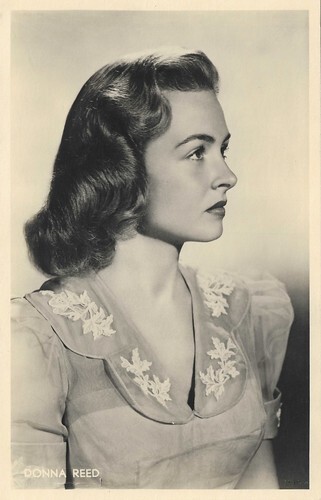
Dutch postcard by S. & v. H., A. Photo: M.P.E.A.
Donna Reed (1921-1986) was an American film and television actress and producer. Her career spanned more than 40 years, with performances in more than 40 films. She is well known for her role as Mary Hatch Bailey in It's a Wonderful Life (Frank Capra, 1946). She received the Oscar for Best Supporting Actress for her role as Lorene Burke in the war drama From Here to Eternity (Fred Zinnemann, 1953). Reed is also known as Donna Stone, a middle-class American mother and housewife in the sitcom The Donna Reed Show (1958–1966).
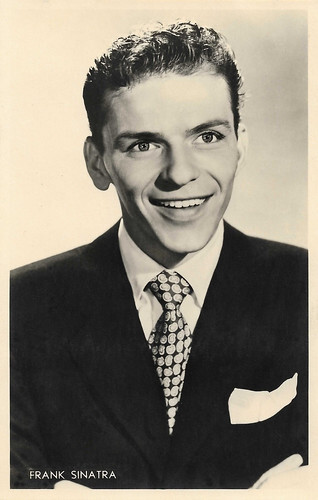
Dutch postcard by S. & v. H., A. Photo: M.P.E.A.
Frank Sinatra (1915-1998) was an American singer, actor, and producer who was one of the most popular and influential musical artists of the 20th century. He is one of the best-selling music artists of all time, having sold more than 150 million records worldwide.
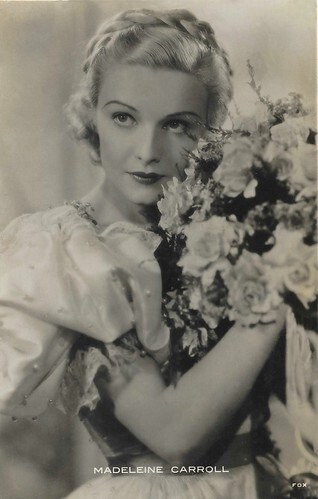
Dutch postcard by Sparo. Photo: Fox.
British actress Madeleine Carroll (1906-1987) was a blonde beauty of ladylike demeanour. The first of Alfred Hitchcock's ‘ice-cool blondes’ was immensely popular in the 1930s and 1940s and was nicknamed 'The Queen of British Cinema'.
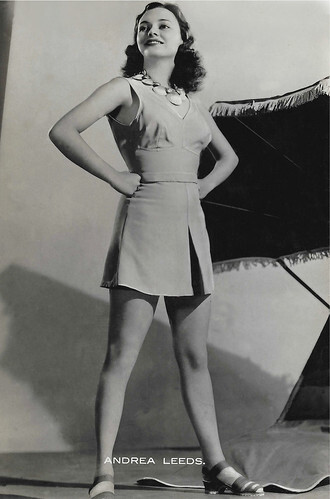
Dutch postcard by Sparo.
Andrea Leeds (1914–1984) was an American film actress who was a popular supporting player of the late 1930s. She was nominated for an Academy Award for Best Supporting Actress for her performance in Stage Door (1937). She did two films with Joel McCrea in which she had the female lead, Youth Takes a Fling (1938) and They Shall Have Music (1939). More leads followed in The Real Glory (1939) with Gary Cooper and Swanee River (1939) with Don Ameche. In 1939, she quit film acting.
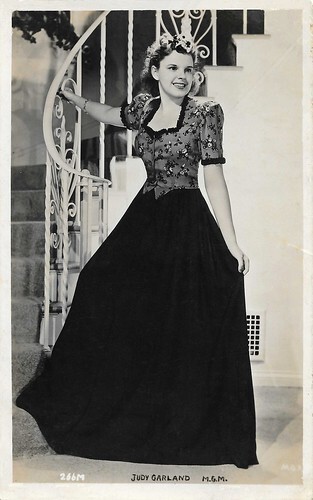
Vintage postcard. Photo: MGM.
Judy Garland (1922-1969) was an American singer, actress, and vaudevillian. During a career that spanned 45 of her 47 years, Garland attained international stardom as an actress in musical and dramatic roles, as a recording artist, and on the concert stage. She was nominated for the Oscar for Best Actress for A Star is Born (1954) and received a nomination for Best Supporting Actress for Judgment at Nuremberg (1961).
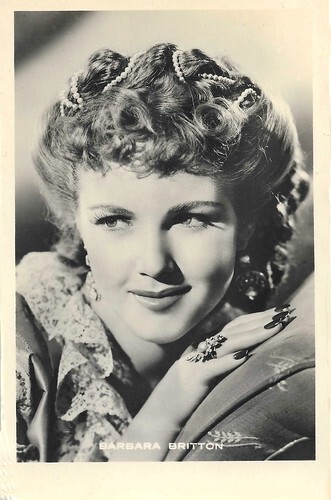
Dutch postcard by HEMO.
Well-coiffed and well-dressed American actress Barbara Britton (1920-1980) co-starred opposite some of Hollywood's most durable leading men, including Randolph Scott, Joel McCrea, Gene Autry, Jeff Chandler and John Hodiak. Later, she became known as TV's Revlon Girl.
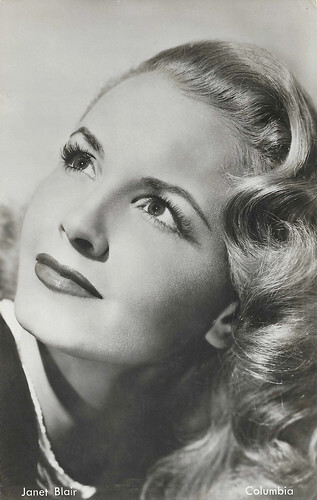
Dutch postcard by DRC, no. 2. Photo: Columbia / MPEA.
American singer and actress Janet Blair (1921-2007) was at Columbia, usually overlooked for the roles that might have tested her dramatic skills. Nevertheless, she pleased audiences as a pert and perky co-star to several bigger stars, ranging from George Raft and Cary Grant to Red Skelton and The Dorsey Brothers.
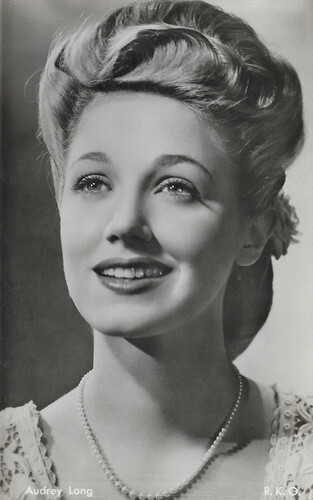
Dutch postcard by DRC, no. 24. Photo: R.K.O. / MPEA.
American actress Audrey Long (1922-2014) was a leading lady in Hollywood low-budget films of the 1940s and early 1950s. From 1944, she starred in B-movies at RKO, Monogram, Republic, and Columbia. She left the film industry in 1952.
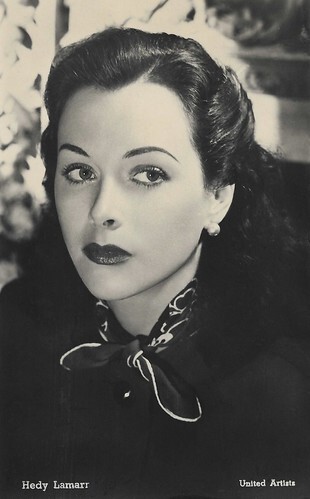
Dutch postcard. Photo: United Artists / M.P.E.A.
And once more, glamorous and seductive film star Hedy Lamarr (1913–2000). In Hollywood, she was usually cast as glamorous and seductive. Her American debut was in Algiers (John Cromwell, 1938). Hedy Lamarr made 18 films between 1940 and 1949, including Boom Town (Jack Conway, 1940), White Cargo (Richard Thorpe, 1942), and Tortilla Flat (Victor Fleming, 1942), based on the novel by John Steinbeck. White Cargo, one of Lamarr's biggest hits at MGM, contains arguably her most famous film quote, "I am Tondelayo". She left MGM in 1945. For Paramount, she appeared as Delilah opposite Victor Mature's Samson in Cecil B. DeMille's epic Samson and Delilah (1949). This proved to be Paramount's most profitable movie to date, bringing in $12 million in rental from theaters. However, following her comedic turn opposite Bob Hope in My Favorite Spy (Norman Z. MacLeod, 1951), her career went into decline.
All postcards: Collection Geoffrey Donaldson Institute. Will be continued on the 15th of next month.

Dutch postcard by J.S.A. Photo: Laszlo Willinger / M.G.M. / M.P.E.
Glamorous and seductive film star Hedy Lamarr (1913–2000) was born in Austria. The notorious Czechoslovak film Ekstase/Ecstasy (1933) made her an international sensation, and Louis Mayer invited her to Hollywood, where she became ‘the most beautiful woman in films’.

Dutch postcard by J.S.A. Photo: Warner / M.P.E.
American film star Bette Davis (1908-1989) was one of the greatest actors in world cinema history. She dared to play unsympathetic, sardonic characters and was reputed for her performances in a range of film genres, from contemporary crime melodramas to historical and period films and occasional comedies. Her greatest successes were her roles in romantic dramas.

Dutch postcard by J.S.A. Photo: F.B.O. / M.P.E. Abbott and Costello in Ride 'Em Cowboy (Arthur Lubin, 1942).
William 'Bud' Abbott (1895–1974) and Lou Costello (1906–1959) were an American comedy duo that first worked together in 1935. Their work in vaudeville and on stage, radio, film and television made them the most popular comedy team during the 1940s and early 1950s.

Dutch postcard by S. & v.H., A. Photo: M.P.E.A.
American actress Paulette Goddard (1905-1990) started her career as a fashion model and as a Ziegfeld Girl in several Broadway shows. In the 1940s, she became a major star at Paramount Pictures. She was Charlie Chaplin's leading lady in Modern Times (1936) and The Great Dictator. Goddard was nominated for an Oscar for Best Supporting Actress for So Proudly We Hail! (1943). Her husbands included Chaplin, Burgess Meredith, and Erich Maria Remarque.

Dutch postcard by S. & v. H., A. Photo: M.P.E.A.
American actress Joan Fontaine (1917-2013) was the younger sister of Hollywood star Olivia de Havilland, but Joan made a name for herself with two classics by Alfred Hitchcock, Rebecca (1941) and Suspicion (1942). For the first she was nominated for the Oscar and for the second she won the award.

Dutch postcard by S. & v. H., A. Photo: M.P.E.A. Sonja Henie and Michael O'Shea in It's a Pleasure (William A. Seiter, 1945).
Petite and glamorous Sonja Henie (1912-1969) was one of the greatest figure skaters in history, the ‘Pavlova of the ice’. She won more Olympic and World titles than any other ladies' figure skater. At the height of her acting career, the Norwegian figure skater and film star was one of the highest-paid stars in Hollywood. She had a shrewd business sense and was immensely successful next with a series of ice revues.

Dutch postcard by S. & v. H., A. Photo: M.P.E.A.
Donna Reed (1921-1986) was an American film and television actress and producer. Her career spanned more than 40 years, with performances in more than 40 films. She is well known for her role as Mary Hatch Bailey in It's a Wonderful Life (Frank Capra, 1946). She received the Oscar for Best Supporting Actress for her role as Lorene Burke in the war drama From Here to Eternity (Fred Zinnemann, 1953). Reed is also known as Donna Stone, a middle-class American mother and housewife in the sitcom The Donna Reed Show (1958–1966).

Dutch postcard by S. & v. H., A. Photo: M.P.E.A.
Frank Sinatra (1915-1998) was an American singer, actor, and producer who was one of the most popular and influential musical artists of the 20th century. He is one of the best-selling music artists of all time, having sold more than 150 million records worldwide.

Dutch postcard by Sparo. Photo: Fox.
British actress Madeleine Carroll (1906-1987) was a blonde beauty of ladylike demeanour. The first of Alfred Hitchcock's ‘ice-cool blondes’ was immensely popular in the 1930s and 1940s and was nicknamed 'The Queen of British Cinema'.

Dutch postcard by Sparo.
Andrea Leeds (1914–1984) was an American film actress who was a popular supporting player of the late 1930s. She was nominated for an Academy Award for Best Supporting Actress for her performance in Stage Door (1937). She did two films with Joel McCrea in which she had the female lead, Youth Takes a Fling (1938) and They Shall Have Music (1939). More leads followed in The Real Glory (1939) with Gary Cooper and Swanee River (1939) with Don Ameche. In 1939, she quit film acting.

Vintage postcard. Photo: MGM.
Judy Garland (1922-1969) was an American singer, actress, and vaudevillian. During a career that spanned 45 of her 47 years, Garland attained international stardom as an actress in musical and dramatic roles, as a recording artist, and on the concert stage. She was nominated for the Oscar for Best Actress for A Star is Born (1954) and received a nomination for Best Supporting Actress for Judgment at Nuremberg (1961).

Dutch postcard by HEMO.
Well-coiffed and well-dressed American actress Barbara Britton (1920-1980) co-starred opposite some of Hollywood's most durable leading men, including Randolph Scott, Joel McCrea, Gene Autry, Jeff Chandler and John Hodiak. Later, she became known as TV's Revlon Girl.

Dutch postcard by DRC, no. 2. Photo: Columbia / MPEA.
American singer and actress Janet Blair (1921-2007) was at Columbia, usually overlooked for the roles that might have tested her dramatic skills. Nevertheless, she pleased audiences as a pert and perky co-star to several bigger stars, ranging from George Raft and Cary Grant to Red Skelton and The Dorsey Brothers.

Dutch postcard by DRC, no. 24. Photo: R.K.O. / MPEA.
American actress Audrey Long (1922-2014) was a leading lady in Hollywood low-budget films of the 1940s and early 1950s. From 1944, she starred in B-movies at RKO, Monogram, Republic, and Columbia. She left the film industry in 1952.

Dutch postcard. Photo: United Artists / M.P.E.A.
And once more, glamorous and seductive film star Hedy Lamarr (1913–2000). In Hollywood, she was usually cast as glamorous and seductive. Her American debut was in Algiers (John Cromwell, 1938). Hedy Lamarr made 18 films between 1940 and 1949, including Boom Town (Jack Conway, 1940), White Cargo (Richard Thorpe, 1942), and Tortilla Flat (Victor Fleming, 1942), based on the novel by John Steinbeck. White Cargo, one of Lamarr's biggest hits at MGM, contains arguably her most famous film quote, "I am Tondelayo". She left MGM in 1945. For Paramount, she appeared as Delilah opposite Victor Mature's Samson in Cecil B. DeMille's epic Samson and Delilah (1949). This proved to be Paramount's most profitable movie to date, bringing in $12 million in rental from theaters. However, following her comedic turn opposite Bob Hope in My Favorite Spy (Norman Z. MacLeod, 1951), her career went into decline.
All postcards: Collection Geoffrey Donaldson Institute. Will be continued on the 15th of next month.
Published on June 14, 2025 22:00
June 13, 2025
Robert Pattinson
Robert Pattinson (1986) is a British actor and musician. He began his career in theatre and made his film debut in 2004. The young Patterson gained attention as Carlo Diggory in Harry Potter and the Goblet of Fire (2005) and became a teen idol as Edward Cullen in the Twilight films (2008-2012). Since then he starred in both major studio productions and independent films and has been ranked among the world's highest-paid actors.
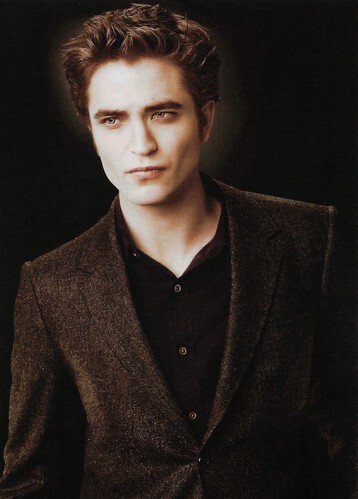
Vintage postcard. Robert Pattinson in Twilight (Catherine Hardwicke, 2008).
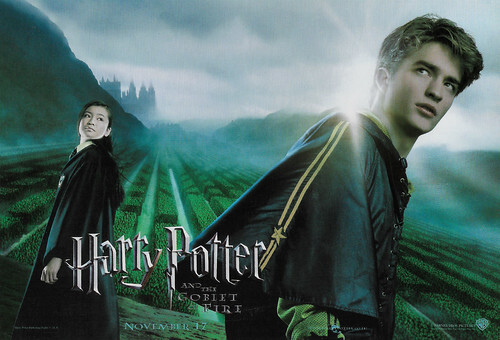
Vintage postcard. Photo: Warner Bros. Robert Pattinson and Katie Leung in Harry Potter and the Goblet of Fire (Mike Newell, 2005).
British star of tomorrow
Robert Douglas Thomas Pattinson was born in a private hospital in Barnes, southwest London, England in 1986. His mother Clare worked as a booker at a modelling agency and his father Richard imported vintage cars from the United States. He has two older sisters, Lizzy and Victoria Pattinson. Lizzy is a singer with the band Aurora and Victoria works in an advertising department.
As a teenager, Robert joined the local amateur theatre club, the Barnes Theatre Company, after his father convinced him to attend because he was quite shy. After two years of working backstage, the 15-year-old Pattinson auditioned for the play 'Guys and Dolls' and he got his first role as a Cuban dancer with no lines. He got the lead part in the next play 'Our Town'. A talent agent in the audience spotted him and he began looking for professional roles.
Pattinson appeared in stage productions such as 'Macbeth', 'Anything Goes' and 'Tess of the d'Urbervilles'. He had supporting roles in the German television film Die Nibelungen – Der Fluch des Drachen / Ring of the Nibelungs (Uli Edel, 2004) with Benno Fürmann and Alicia Witt, and in the costume drama Vanity Fair (Mira Nair, 2004) as Reese Witherspoon's son. His scenes were cut out of the final film. Pattinson didn't know about it until he attended the premiere. The casting director felt so guilty for not telling him, that she got him an audition for the new Harry Potter film.
In 2005, he was due to appear in 'The Woman Before' at the Royal Court Theatre but was fired shortly before and replaced by Tom Riley. Later that year, he played Carlo Diggory in Harry Potter and the Goblet of Fire (Mike Newell, 2005). It brought him to a wider audience at the age of 19 and soon after, he was even named 'British Star of Tomorrow' by Times Online . He continued to star in mostly smaller British TV productions. As a model, Pattinson appeared in the ad campaign for Hackett's 2007 autumn collection. Pattinson appeared in Little Ashes (Paul Morrison, 2008), in which he played Salvador Dalí, the British comedy How to Be (Oliver Irving, 2008), and the short film The Summer House (Daisy Gili, 2009).
Occasionally, he sent audition tapes for roles in America. One, for a rom-com, led to the opportunity for an in-person audition in Los Angeles. That audition did not pan out, but while in town he went in for another, with director Catherine Hardwicke, for a part in an adaptation of a low-profile book about a vampire. His role as vampire Edward Cullen opposite Kristen Stewart as Bella Swan in Twilight (Catherine Hardwicke, 2008), suddenly turned him into a worldwide star and a teen idol.
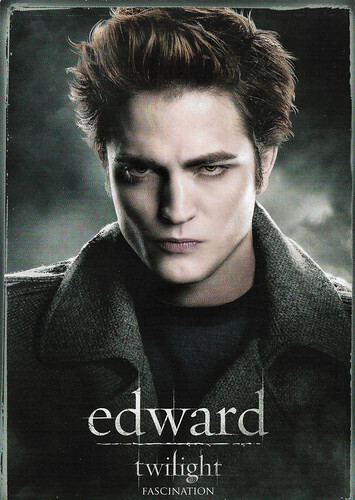
Belgian freecard by Boomerang. Photo: Belgafilms. Robert Pattinson in Twilight (Catherine Hardwicke, 2008). Caption: Fascination.
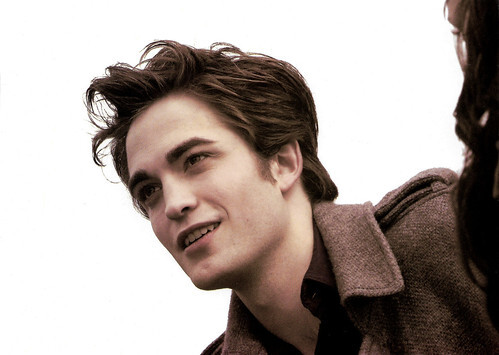
Vintage postcard. Robert Pattinson in Twilight (Catherine Hardwicke, 2008). Caption: When you can live forever, What do you live for?
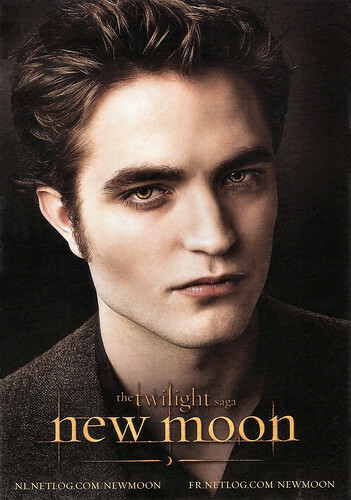
Belgian freecard by Boomerang. Photo: Belgafilms. Robert Pattinson in The Twilight Saga - New Moon (2009).
Sexiest man in the world at 22
At age 22, Robert Pattinson was voted ‘sexiest man in the world’ by Glamour magazine, before Brad Pitt. Hugh Jackman and Johnny Depp. Between 2008 and 2012, the five film adaptations of the Twilight novels written by Stephenie Meyer grossed over $3.3 billion in worldwide receipts. Between the Twilight Saga films, he also starred in Remember Me (Allen Coulter, 2010), Water for Elephants (Francis Lawrence, 2011) with Reese Witherspoon, and Bel Ami (Declan Donnellan, Nick Ormerod, 2012) alongside Uma Thurman and Kristin Scott Thomas.
Pattinson's Twilight era was surreal. He had been catapulted onto Hollywood's A-list as a heartthrob, but also experienced certain preconceptions about what he wanted - or was capable of doing - as an actor. That changed with an unexpected straight offer from auteur director David Cronenberg to star in Cosmopolis (2012), which he described as an eye-opening experience. It reminded him of his love for cinema, why he wanted to become an actor in the first place and solidified his foremost desire for the coming years to work with great filmmakers.
With Pattinson being a big cinephile, he then starred in mostly independent films from auteur directors, such as The Rover (David Michôd, 2014) opposite Guy Pearce, Maps to the Stars (David Cronenberg, 2014) starring Julianne Moore, Life (Anton Corbijn, 2015), Queen of the Desert (Werner Herzog, 2015) with Nicole Kidman and The Childhood of a Leader (Brady Corbet, 2015). He also became the face of Dior Homme fragrance in 2013 and the face of Dior Homme menswear in 2016. His unrecognisable role as an explorer in the Amazon jungle in Lost City of Z (James Gray, 2016) brought him critical acclaim. His transformation to a sleazy, manic conman in the gritty crime thriller Good Time (Benny Safdie, Josh Safdie, 2017) earned him a standing ovation at the Cannes Film Festival. His role was written specifically for him after sending a spontaneous email to the directors, the Safdie Brothers, without knowing them and seeing only a movie still on the internet from their previous film Heaven Knows What (2014).
Next, he starred in the Western comedy Damsel (David Zellner, Nathan Zellner, 2018) as a cowboy with sociopathic characteristics and played a convict sent to space for sexual experimentation in the psychological mystery drama High Life (2018) from acclaimed French auteur director Claire Denis. He returned to work with director David Michôd in The King (David Michôd, 2019) and starred with Willem Dafoe in the Fantasy-Horror film The Lighthouse (Robert Eggers, 2019), set on a remote New England island in the 1890s. The film earned good reviews for both its storytelling and Pattinson's performance. In Netflix's The Devil All the Time (Antonio Campos, 2020), Pattinson played a corrupt preacher preying on young girls.
Robert Pattinson returned to mainstream films with a leading role in Christopher Nolan's time-bending Spy film Tenet (2020) and starred as the superhero and his secret alter ego Bruce Wayne in The Batman (Matt Reeves, 2022). Next followed Bong Joon-ho's Science Fiction film Mickey 17 (2025), in which Pattinson played the lead role. He portrayed Mickey Barnes, a disposable crew member on a space mission who is assigned perilous tasks, as he can be regenerated upon death while retaining most of his memories. The film received mostly positive reviews, with most of the focus on Pattinson's performance as dual versions of the same character. Robert Pattinson was in a relationship with Kristen Stewart from mid-2009 until May 2013 and with British singer FKA Twigs, from 2014 to 2017. Since 2018, he has been dating British actress and singer Suki Waterhouse. In 2024, the couple became parents to a daughter.
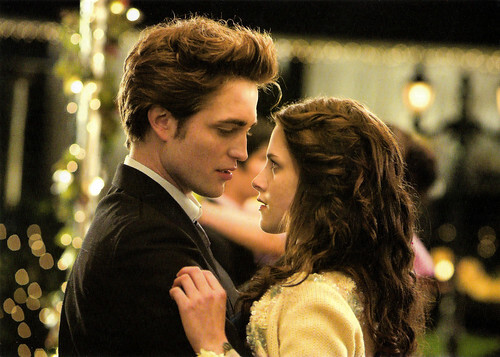
Vintage postcard. Robert Pattinson and Kristen Stewart in Twilight (Catherine Hardwicke, 2008). Caption: When you van live forever, What do you live for?
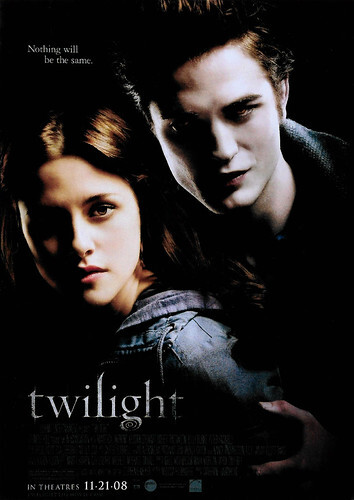
English postcard by Cinema. Kristen Stewart and Robert Pattinson in Twilight (Catherine Hardwicke, 2008). Caption: Nothing will be the same.
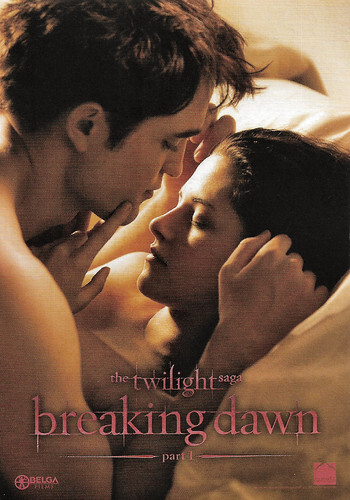
Belgian freecard by Boomerang. Photo: Belgafilms. Robert Pattinson and Kristin Stewart in The Twilight Saga: Breaking Dawn - Part 1 (Bill Condon, 2011).
Sources: Wikipedia (Dutch, German and English) and .

Vintage postcard. Robert Pattinson in Twilight (Catherine Hardwicke, 2008).

Vintage postcard. Photo: Warner Bros. Robert Pattinson and Katie Leung in Harry Potter and the Goblet of Fire (Mike Newell, 2005).
British star of tomorrow
Robert Douglas Thomas Pattinson was born in a private hospital in Barnes, southwest London, England in 1986. His mother Clare worked as a booker at a modelling agency and his father Richard imported vintage cars from the United States. He has two older sisters, Lizzy and Victoria Pattinson. Lizzy is a singer with the band Aurora and Victoria works in an advertising department.
As a teenager, Robert joined the local amateur theatre club, the Barnes Theatre Company, after his father convinced him to attend because he was quite shy. After two years of working backstage, the 15-year-old Pattinson auditioned for the play 'Guys and Dolls' and he got his first role as a Cuban dancer with no lines. He got the lead part in the next play 'Our Town'. A talent agent in the audience spotted him and he began looking for professional roles.
Pattinson appeared in stage productions such as 'Macbeth', 'Anything Goes' and 'Tess of the d'Urbervilles'. He had supporting roles in the German television film Die Nibelungen – Der Fluch des Drachen / Ring of the Nibelungs (Uli Edel, 2004) with Benno Fürmann and Alicia Witt, and in the costume drama Vanity Fair (Mira Nair, 2004) as Reese Witherspoon's son. His scenes were cut out of the final film. Pattinson didn't know about it until he attended the premiere. The casting director felt so guilty for not telling him, that she got him an audition for the new Harry Potter film.
In 2005, he was due to appear in 'The Woman Before' at the Royal Court Theatre but was fired shortly before and replaced by Tom Riley. Later that year, he played Carlo Diggory in Harry Potter and the Goblet of Fire (Mike Newell, 2005). It brought him to a wider audience at the age of 19 and soon after, he was even named 'British Star of Tomorrow' by Times Online . He continued to star in mostly smaller British TV productions. As a model, Pattinson appeared in the ad campaign for Hackett's 2007 autumn collection. Pattinson appeared in Little Ashes (Paul Morrison, 2008), in which he played Salvador Dalí, the British comedy How to Be (Oliver Irving, 2008), and the short film The Summer House (Daisy Gili, 2009).
Occasionally, he sent audition tapes for roles in America. One, for a rom-com, led to the opportunity for an in-person audition in Los Angeles. That audition did not pan out, but while in town he went in for another, with director Catherine Hardwicke, for a part in an adaptation of a low-profile book about a vampire. His role as vampire Edward Cullen opposite Kristen Stewart as Bella Swan in Twilight (Catherine Hardwicke, 2008), suddenly turned him into a worldwide star and a teen idol.

Belgian freecard by Boomerang. Photo: Belgafilms. Robert Pattinson in Twilight (Catherine Hardwicke, 2008). Caption: Fascination.

Vintage postcard. Robert Pattinson in Twilight (Catherine Hardwicke, 2008). Caption: When you can live forever, What do you live for?

Belgian freecard by Boomerang. Photo: Belgafilms. Robert Pattinson in The Twilight Saga - New Moon (2009).
Sexiest man in the world at 22
At age 22, Robert Pattinson was voted ‘sexiest man in the world’ by Glamour magazine, before Brad Pitt. Hugh Jackman and Johnny Depp. Between 2008 and 2012, the five film adaptations of the Twilight novels written by Stephenie Meyer grossed over $3.3 billion in worldwide receipts. Between the Twilight Saga films, he also starred in Remember Me (Allen Coulter, 2010), Water for Elephants (Francis Lawrence, 2011) with Reese Witherspoon, and Bel Ami (Declan Donnellan, Nick Ormerod, 2012) alongside Uma Thurman and Kristin Scott Thomas.
Pattinson's Twilight era was surreal. He had been catapulted onto Hollywood's A-list as a heartthrob, but also experienced certain preconceptions about what he wanted - or was capable of doing - as an actor. That changed with an unexpected straight offer from auteur director David Cronenberg to star in Cosmopolis (2012), which he described as an eye-opening experience. It reminded him of his love for cinema, why he wanted to become an actor in the first place and solidified his foremost desire for the coming years to work with great filmmakers.
With Pattinson being a big cinephile, he then starred in mostly independent films from auteur directors, such as The Rover (David Michôd, 2014) opposite Guy Pearce, Maps to the Stars (David Cronenberg, 2014) starring Julianne Moore, Life (Anton Corbijn, 2015), Queen of the Desert (Werner Herzog, 2015) with Nicole Kidman and The Childhood of a Leader (Brady Corbet, 2015). He also became the face of Dior Homme fragrance in 2013 and the face of Dior Homme menswear in 2016. His unrecognisable role as an explorer in the Amazon jungle in Lost City of Z (James Gray, 2016) brought him critical acclaim. His transformation to a sleazy, manic conman in the gritty crime thriller Good Time (Benny Safdie, Josh Safdie, 2017) earned him a standing ovation at the Cannes Film Festival. His role was written specifically for him after sending a spontaneous email to the directors, the Safdie Brothers, without knowing them and seeing only a movie still on the internet from their previous film Heaven Knows What (2014).
Next, he starred in the Western comedy Damsel (David Zellner, Nathan Zellner, 2018) as a cowboy with sociopathic characteristics and played a convict sent to space for sexual experimentation in the psychological mystery drama High Life (2018) from acclaimed French auteur director Claire Denis. He returned to work with director David Michôd in The King (David Michôd, 2019) and starred with Willem Dafoe in the Fantasy-Horror film The Lighthouse (Robert Eggers, 2019), set on a remote New England island in the 1890s. The film earned good reviews for both its storytelling and Pattinson's performance. In Netflix's The Devil All the Time (Antonio Campos, 2020), Pattinson played a corrupt preacher preying on young girls.
Robert Pattinson returned to mainstream films with a leading role in Christopher Nolan's time-bending Spy film Tenet (2020) and starred as the superhero and his secret alter ego Bruce Wayne in The Batman (Matt Reeves, 2022). Next followed Bong Joon-ho's Science Fiction film Mickey 17 (2025), in which Pattinson played the lead role. He portrayed Mickey Barnes, a disposable crew member on a space mission who is assigned perilous tasks, as he can be regenerated upon death while retaining most of his memories. The film received mostly positive reviews, with most of the focus on Pattinson's performance as dual versions of the same character. Robert Pattinson was in a relationship with Kristen Stewart from mid-2009 until May 2013 and with British singer FKA Twigs, from 2014 to 2017. Since 2018, he has been dating British actress and singer Suki Waterhouse. In 2024, the couple became parents to a daughter.

Vintage postcard. Robert Pattinson and Kristen Stewart in Twilight (Catherine Hardwicke, 2008). Caption: When you van live forever, What do you live for?

English postcard by Cinema. Kristen Stewart and Robert Pattinson in Twilight (Catherine Hardwicke, 2008). Caption: Nothing will be the same.

Belgian freecard by Boomerang. Photo: Belgafilms. Robert Pattinson and Kristin Stewart in The Twilight Saga: Breaking Dawn - Part 1 (Bill Condon, 2011).
Sources: Wikipedia (Dutch, German and English) and .
Published on June 13, 2025 22:00
June 12, 2025
Max Adalbert
German stage and film actor Max Adalbert (1874-1933) was one of the great names of the German theatre at the beginning of the twentieth century. He was famous for his roles in comedies. His greatest success was the title role in the comedy Der Hauptmann von Köpenick / The Captain from Köpenick (1931) which he played on stage and in the cinema.
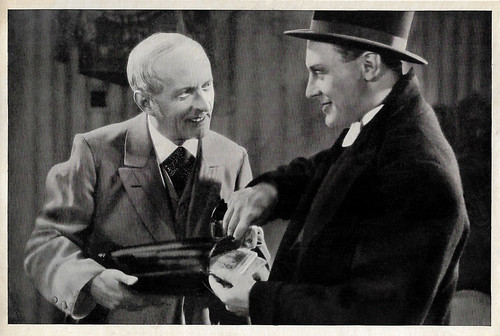
German collectors card in the series 'Vom Werden deutscher Filmkunst - Der Tonfilm', album no. 11, picture no. 131. Photo: Messtro-Film / Ross Verlag. Max Adalbert and Harald Paulsen in Mein Leopold / My Leopold (Hans Steinhoff, 1931).
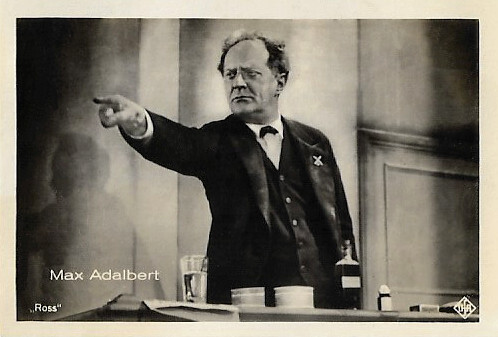
German cigarette card for Hänsom cigarettes by Jasmatzi Cigarettenfabrik G.M.b.H, Dresden/Ross Verlag, Film Series 4 'Aus tönenden Filmen' (From sound films), no. 572. Photo: Ufa. Max Adalbert in Das Ekel / The Scoundrel (Eugen Schüfftan, Franz Wenzler, 1931).
Missing the possibility of using words
Max Adalbert was born Maximilian Adalbert Krampf in 1874 in Danzig in Imperial Germany, now Gdansk in Poland. He was the son of a Prussian Officer.
Using his first two names as his stage name, he debuted at 19 at the theatre of Lübeck and in 1894 at the municipal theatre of Barmen. Adalbert also appeared in St. Gallen (Switzerland), Nuremberg and Vienna (Austria). He moved to Berlin in 1899 to work at the Residenztheater.
In 1915, Adalbert joined the film business. In the following years, he took part in silent productions like Wie werde ich Amanda los? / How do I get rid of Amanda? (Danny Kaden, 1915), Die Buchhalterin / The Accountant (Paul von Woringen, 1918) with Lotte Neumann , König Nicolo / King Nicolo (Paul Legband, 1919) starring Ernst Stahl-Nachbaur, and the crime drama Die Verführten / The Seduced (Carl Froelich, 1919) in which he played the seducer.
When Adalbert came in contact with Curt Bois, he turned into a comedian. During the 1920s, Max Adalbert appeared in several silent films, including Der Dummkopf / The Blockhead (Lupu Pick, 1921), Lady Hamilton (Richard Oswald, 1921) starring Liane Haid , and Die Flamme / The Flame (Ernst Lubitsch, 1923) starring Pola Negri . The highlights are two masterpieces by Fritz Lang , Der müde Tod / Destiny (Fritz Lang, 1921) and Dr. Mabuse der Spieler / Mabuse the Gambler (Fritz Lang, 1922), the first film in the Dr. Mabuse series about the master criminal who featured in the novels of Norbert Jacques.
In 1923, Max Adalbert retired temporarily from the cinema because he missed the possibility of using words. Together with the actors Paul Morgan and Kurt Robitschek, he founded the 'Kabarett der Komiker' in 1924 which soon became established in Berlin and enjoyed great popularity.
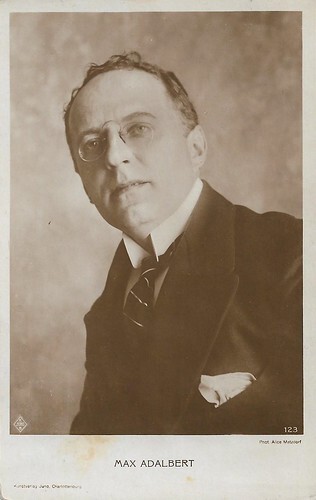
German postcard by Kunstverlag Juno, Charlottenburg, no. 123. Photo: Alice Matzdorf.
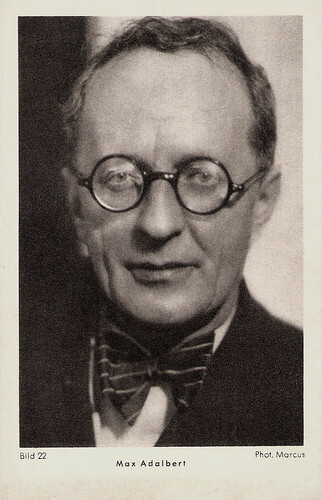
German postcard for 'Die trustfreie Eidelsan' by Margarinewerk Eidelstedt Gebr. Fauser G.m.b.H., Holstein, Serie 1, no. 22. Photo: Marcus.
An enormous increase in his popularity
After a few years solely devoted to the stage, Max Adalbert successfully returned to the cinema when sound film was introduced in Germany. Both on stage and in films, he experienced an enormous increase in his popularity. He was very good in the film comedy Mein Leopold / My Leopold (Hans Steinhoff, 1931) opposite Harald Paulsen as Leopold.
In 1931 he also made his debut at the Deutsches Theater in Berlin as the lead character of Carl Zuckmayer's 'Der Hauptmann von Köpenick'. He took the role over from Werner Krauss and it became his greatest triumph on stage.
Because of this huge success, he was also engaged in the film adaptation, Der Hauptmann von Köpenick / The Captain from Köpenick (Richard Oswald, 1931). The story centres on the Hauptmann von Köpenick affair in 1906. With this role, he set a cinematic monument for himself.
He also appeared in the comedy Das Ekel / The Scoundrel (Eugen Schüfftan. Franz Wenzler, 1931) with Evelyn Holt , musical romance Mein Herz sehnt sich nach Liebe / My Heart Longs for Love (Eugen Thiele, 1931) starring Trude Berliner , and the comedy Lachende Erben / Laughing Heirs (Max Ophüls, 1933) starring Heinz Rühmann .
In 1933, Max Adalbert suddenly died - of pneumonia or a heart attack (the sources differ) - while in Munich for a guest performance. He was 58. The actor was buried at the Stahnsdorf South-Western Cemetery near Berlin.
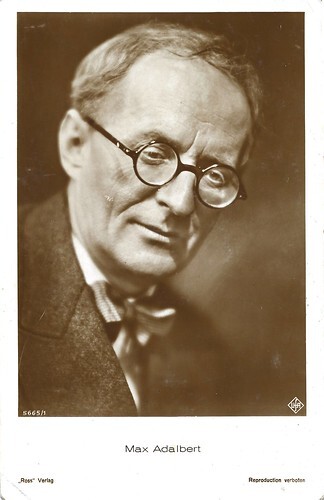
German postcard by Ross Verlag, no. 5665/1, 1930-1931. Photo: Ufa.
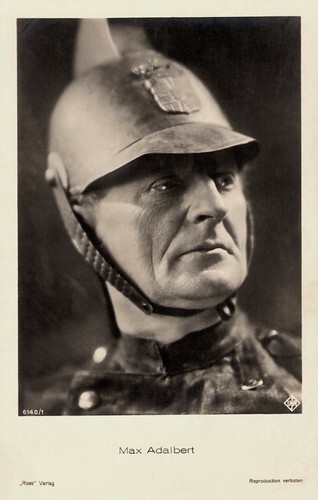
German postcard by Ross Verlag, no. 6140/1, 1931-1932. Photo: Ufa. Max Adalbert in Die Schlacht von Bademünde / The Battle of Bademuende (Philipp Lothar Mayring, 1931).
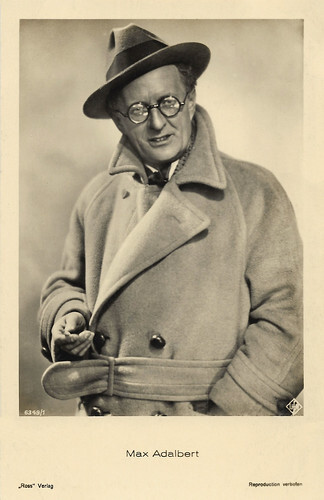
German postcard by Ross Verlag, no. 6349/1, 1931-1932. Photo: Ufa.
Sources: (IMDb), Wikipedia (English and German) and .

German collectors card in the series 'Vom Werden deutscher Filmkunst - Der Tonfilm', album no. 11, picture no. 131. Photo: Messtro-Film / Ross Verlag. Max Adalbert and Harald Paulsen in Mein Leopold / My Leopold (Hans Steinhoff, 1931).

German cigarette card for Hänsom cigarettes by Jasmatzi Cigarettenfabrik G.M.b.H, Dresden/Ross Verlag, Film Series 4 'Aus tönenden Filmen' (From sound films), no. 572. Photo: Ufa. Max Adalbert in Das Ekel / The Scoundrel (Eugen Schüfftan, Franz Wenzler, 1931).
Missing the possibility of using words
Max Adalbert was born Maximilian Adalbert Krampf in 1874 in Danzig in Imperial Germany, now Gdansk in Poland. He was the son of a Prussian Officer.
Using his first two names as his stage name, he debuted at 19 at the theatre of Lübeck and in 1894 at the municipal theatre of Barmen. Adalbert also appeared in St. Gallen (Switzerland), Nuremberg and Vienna (Austria). He moved to Berlin in 1899 to work at the Residenztheater.
In 1915, Adalbert joined the film business. In the following years, he took part in silent productions like Wie werde ich Amanda los? / How do I get rid of Amanda? (Danny Kaden, 1915), Die Buchhalterin / The Accountant (Paul von Woringen, 1918) with Lotte Neumann , König Nicolo / King Nicolo (Paul Legband, 1919) starring Ernst Stahl-Nachbaur, and the crime drama Die Verführten / The Seduced (Carl Froelich, 1919) in which he played the seducer.
When Adalbert came in contact with Curt Bois, he turned into a comedian. During the 1920s, Max Adalbert appeared in several silent films, including Der Dummkopf / The Blockhead (Lupu Pick, 1921), Lady Hamilton (Richard Oswald, 1921) starring Liane Haid , and Die Flamme / The Flame (Ernst Lubitsch, 1923) starring Pola Negri . The highlights are two masterpieces by Fritz Lang , Der müde Tod / Destiny (Fritz Lang, 1921) and Dr. Mabuse der Spieler / Mabuse the Gambler (Fritz Lang, 1922), the first film in the Dr. Mabuse series about the master criminal who featured in the novels of Norbert Jacques.
In 1923, Max Adalbert retired temporarily from the cinema because he missed the possibility of using words. Together with the actors Paul Morgan and Kurt Robitschek, he founded the 'Kabarett der Komiker' in 1924 which soon became established in Berlin and enjoyed great popularity.

German postcard by Kunstverlag Juno, Charlottenburg, no. 123. Photo: Alice Matzdorf.

German postcard for 'Die trustfreie Eidelsan' by Margarinewerk Eidelstedt Gebr. Fauser G.m.b.H., Holstein, Serie 1, no. 22. Photo: Marcus.
An enormous increase in his popularity
After a few years solely devoted to the stage, Max Adalbert successfully returned to the cinema when sound film was introduced in Germany. Both on stage and in films, he experienced an enormous increase in his popularity. He was very good in the film comedy Mein Leopold / My Leopold (Hans Steinhoff, 1931) opposite Harald Paulsen as Leopold.
In 1931 he also made his debut at the Deutsches Theater in Berlin as the lead character of Carl Zuckmayer's 'Der Hauptmann von Köpenick'. He took the role over from Werner Krauss and it became his greatest triumph on stage.
Because of this huge success, he was also engaged in the film adaptation, Der Hauptmann von Köpenick / The Captain from Köpenick (Richard Oswald, 1931). The story centres on the Hauptmann von Köpenick affair in 1906. With this role, he set a cinematic monument for himself.
He also appeared in the comedy Das Ekel / The Scoundrel (Eugen Schüfftan. Franz Wenzler, 1931) with Evelyn Holt , musical romance Mein Herz sehnt sich nach Liebe / My Heart Longs for Love (Eugen Thiele, 1931) starring Trude Berliner , and the comedy Lachende Erben / Laughing Heirs (Max Ophüls, 1933) starring Heinz Rühmann .
In 1933, Max Adalbert suddenly died - of pneumonia or a heart attack (the sources differ) - while in Munich for a guest performance. He was 58. The actor was buried at the Stahnsdorf South-Western Cemetery near Berlin.

German postcard by Ross Verlag, no. 5665/1, 1930-1931. Photo: Ufa.

German postcard by Ross Verlag, no. 6140/1, 1931-1932. Photo: Ufa. Max Adalbert in Die Schlacht von Bademünde / The Battle of Bademuende (Philipp Lothar Mayring, 1931).

German postcard by Ross Verlag, no. 6349/1, 1931-1932. Photo: Ufa.
Sources: (IMDb), Wikipedia (English and German) and .
Published on June 12, 2025 22:00
June 11, 2025
George Peppard
During the 1960s, handsome and elegant actor George Peppard (1928-1994) displayed considerable talent in such films as Breakfast at Tiffany's (1961), How the West Was Won (1962), The Carpetbaggers (1964) and The Blue Max (1966). But he is probably best known as Col. John 'Hannibal' Smith, the cigar-smoking leader of a renegade commando squad in the action series The A-Team (1983-1987).
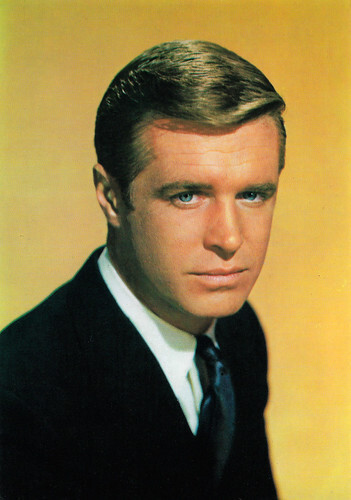
Italian postcard by Rotalcolor / Rotalfoto, no. N 228.
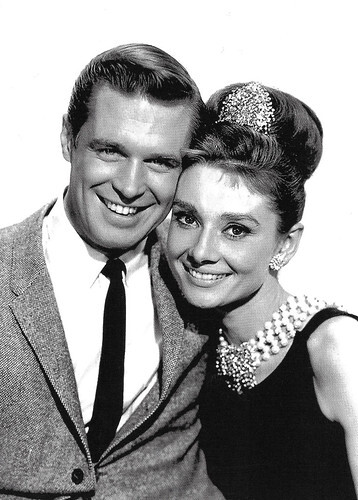
Chinese postcard. George Peppard and Audrey Hepburn in Breakfast at Tiffany's (Blake Edwards, 1961).
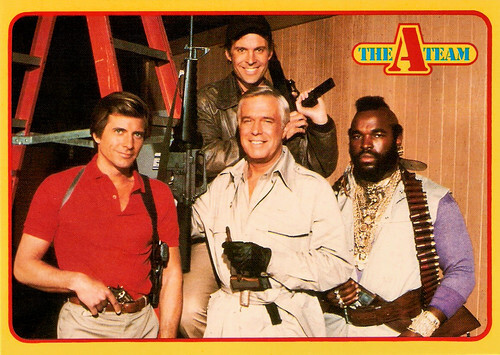
Dutch postcard by Gebr. Spanjersberg, Rotterdam / Antwerpen. Photo: Stephen J. Cannell Productions, 1984. Dirk Benedict as Templeton 'Faceman' Peck, George Peppard as Colonel John 'Hannibal' Smith, Dwight Schultz as 'Howling Mad' Murdock, and Mr. T as Sergeant First Class Bosco Baracus in The A-Team (1983-1987).
Good looks, elegant manner and acting skills
George Peppard Jr. was born in Detroit, Michigan, in 1928. He was the son of contractor George Peppard and opera singer Vernelle Rohrer. Before his acting career began, he was a newsreader for a local radio station in Pittsburgh for a short time. After radio and television experience (with guest roles in The United States Steel Hour, Alfred Hitchcock Presents and The Alcoa Hour), Peppard made his Broadway debut in 1956, in the play 'Girls of Summer'.
He made his feature film debut in the drama The Strange One (Jack Garfein, 1957). In 1958-1959, he played Roger Henderson in the play 'The Pleasure of His Company'. In the late 1950s, Peppard continued to make guest appearances in then-famous television shows and series, like Studio One, Hallmark Hall of Fame and Matinee Theatre. He also had a role in the war film Pork Chop Hill (Lewis Milestone, 1959), starring Gregory Peck .
Peppard began to stand out after his role as Robert Mitchum 's illegitimate son in Home from the Hill (Vincente Minnelli, 1960). He began to emerge more and more as the leading man, but the Beatnik film The Subterraneans (Ranald MacDougall, 1960) flopped and he returned to television. His good looks, elegant manner and acting skills landed Peppard his most famous film role as struggling writer Paul ‘Fred’ Varjak in the romantic comedy Breakfast at Tiffany's (Blake Edwards, 1961), alongside Audrey Hepburn .
Now considered a promising young star by the studios, Peppard was cast in the epic Western How the West Was Won (Henry Hathaway, John Ford, George Marshall, 1962), the British-American war film The Victors (Carl Foreman, 1963) and the Harold Robbins adaptation The Carpetbaggers (Edward Dmytryk, 1964) in which he portrayed a character based on Howard Hughes. His future second wife Helen Davies also had a role in the latter film. In the mid-1960s, Peppard starred in major productions such as the British Spy thriller Operation Crossbow (Michael Anderson, 1965) with Sophia Loren and the thriller The Third Day (Jack Smight, 1965) with Elizabeth Ashley, who had become his third wife.
He reached the peak of his popularity in the grim war film The Blue Max (John Guillermin, 1966) with Peppard as an obsessively competitive German pilot during World War I. In the latter half of the 1960s and early 1970s, Peppard seemed to lower the bar and appeared in films of a more average level, except for the war film Tobruk (Arthur Hiller, 1967) in which he co-starred with Rock Hudson . He also appeared in the Westerns Rough Night in Jericho (Arnold Laven, 1967) with Dean Martin and One More Train To Rob (Andrew McLaglen, 1971). Peppard co-starred with Joan Collins in the British Cold War thriller The Executioner (Sam Wanamaker, 1970).
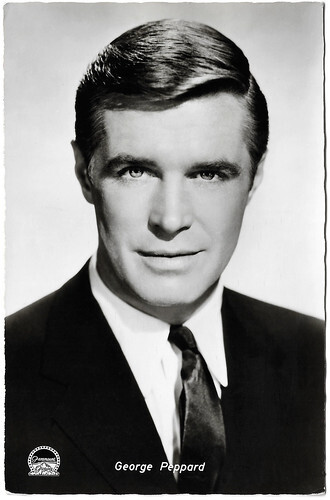
West German Kolibri postcard by Friedrich W. Sander-Verlag, Minden/Westf, no. 2329. Photo: Paramount. George Peppard in The Carpetbaggers (Edward Dmytryk, 1964).
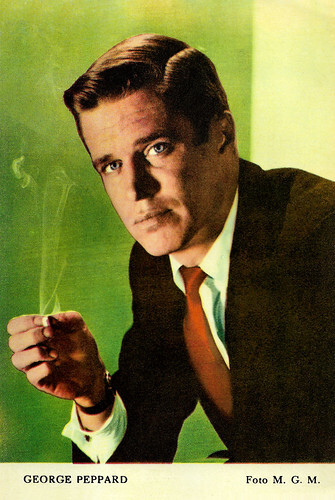
Vintage postcard. Photo: M.G.M.
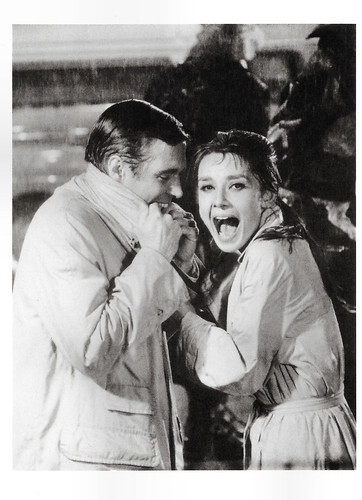
Swiss postcard by CVB Publishers / News Productions, no. 57244. Photo: Collection Cinemathèque Suisse Lausanne. Audrey Hepburn and George Peppard in Breakfast at Tiffany's (Blake Edwards, 1961).
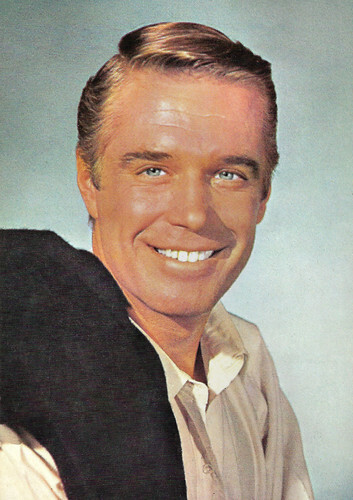
Romanian postcard by Casa Filmului Acin.
The number-one-rated television show of 1983
In the 1970s, the film roles George Peppard took on became increasingly uninteresting and he played almost exclusively in television films. Between 1972 and 1974, Peppard starred in the seventeen-episode television series Banacek. He played a wealthy Boston playboy who solves thefts for insurance companies for a finder's fee in 90-minute whodunits. The series briefly revived Peppard's waning popularity. In 1975-1976, he starred in the television series Doctor's Hospital, but towards the end of the season, Peppard indicated he wanted to quit his role in the series.
In 1977, Peppard appeared in the post-apocalypse film Damnation Alley (Jack Smight, 1977) with Jan-Michael Vincent and Dominique Sanda . Poorly received by critics and audiences, it has since achieved a cult following. With fewer interesting roles coming his way, he acted in, directed and produced the drama Five Days from Home (1979). The film, about a father escaping from prison to visit his sick son, did not become a success.
He plunged back into television films like Torn Between Two Lovers (Delbert Mann, 1979) with Lee Remick and Crisis in Mid-Air (Walter Grauman, 1979). The Euro War film Contro 4 Bandiere/From Hell to Victory (Umberto Lenzi, 1979) and the Space Opera Battle Beyond the Stars (Jimmy T. Murakami, 1980), produced by Roger Corman, also did not become box office hits. He landed the role of Blake Carrington in the TV soap Dynasty but was fired after a week of filming due to creative differences with the producers.
He managed to get the role of Hannibal Smith in The A-Team, alongside Mr. T, Dirk Benedict and Dwight Schultz. In the series, the A-Team was a team of renegade commandos on the run from the military for "a crime they did not commit" while serving in the Vietnam War. The A-Team members made their collective living as soldiers of fortune, but they helped only people who came to them with justified grievances. The A-Team became the number-one-rated television show in its first season. 98 episodes of the series were made and aired between 1983 and 1987. Peppard was back in the saddle, but after the series ended, he reportedly was glad it was over.
He starred in a few more films and television movies, including two films in the Man Against the Mob series, for which a third was also planned. Due to Peppard's death, it remained only two parts. Furthermore, he played a role in the War film Night of the Fox (Charles Jarrott, 1990) with Michael York . Peppard's last television appearance was a guest role in the television series Matlock. The episode aired eight days before Peppard's death. It was intended as a pilot for a new series. In 1992, Peppard had a small, malignant lung tumour removed. Two years later, George Peppard was again under treatment for lung cancer. Complications from this left him with pneumonia, from which he eventually died in 1994. He was 65. His fifth wife Laura, a West Palm Beach banker, cared for him for the last 18 months of his life. He is buried alongside his parents in Northview Cemetery in Dearborn, Michigan.
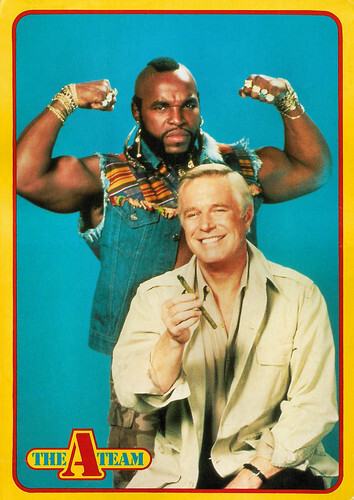
Dutch postcard by Gebr. Spanjersberg, Rotterdam / Antwerpen. Photo: Stephen J. Cannell Productions, 1984. George Peppard as Colonel John 'Hannibal' Smith and Mr. T as Sergeant First Class Bosco Baracus in The A-Team (1983-1987).
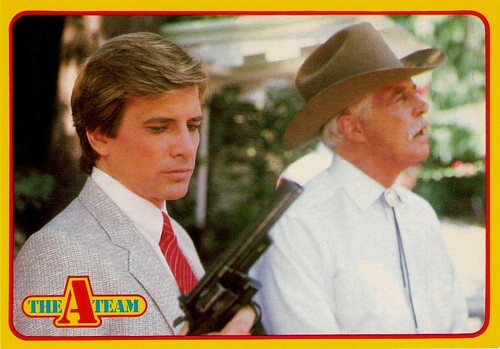
Dutch postcard by Gebr. Spanjersberg, Rotterdam / Antwerpen. Photo: Stephen J. Cannell Productions, 1984. Dirk Benedict as Templeton 'Faceman' Peck and George Peppard as Colonel John 'Hannibal' Smith in The A-Team (1983-1987).
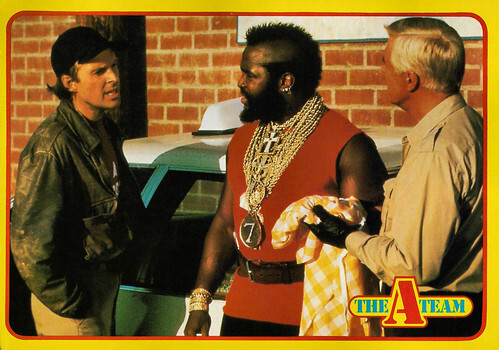
Dutch postcard by Gebr. Spanjersberg, Rotterdam / Antwerpen. Photo: Stephen J. Cannell Productions, 1984. Dwight Schulz, Mr. T and George Peppard in The A-Team (1983-1987).
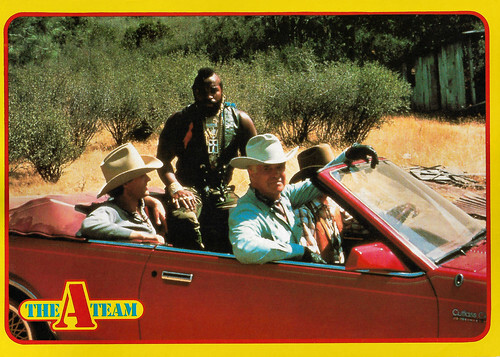
Dutch postcard by Gebr. Spanjersberg, Rotterdam / Antwerpen. Photo: Stephen J. Cannell Productions, 1984. Dwight Schulz, Mr. T and George Peppard in The A-Team (1983-1987).
Sources: Wikipedia (Dutch and English) and .

Italian postcard by Rotalcolor / Rotalfoto, no. N 228.

Chinese postcard. George Peppard and Audrey Hepburn in Breakfast at Tiffany's (Blake Edwards, 1961).

Dutch postcard by Gebr. Spanjersberg, Rotterdam / Antwerpen. Photo: Stephen J. Cannell Productions, 1984. Dirk Benedict as Templeton 'Faceman' Peck, George Peppard as Colonel John 'Hannibal' Smith, Dwight Schultz as 'Howling Mad' Murdock, and Mr. T as Sergeant First Class Bosco Baracus in The A-Team (1983-1987).
Good looks, elegant manner and acting skills
George Peppard Jr. was born in Detroit, Michigan, in 1928. He was the son of contractor George Peppard and opera singer Vernelle Rohrer. Before his acting career began, he was a newsreader for a local radio station in Pittsburgh for a short time. After radio and television experience (with guest roles in The United States Steel Hour, Alfred Hitchcock Presents and The Alcoa Hour), Peppard made his Broadway debut in 1956, in the play 'Girls of Summer'.
He made his feature film debut in the drama The Strange One (Jack Garfein, 1957). In 1958-1959, he played Roger Henderson in the play 'The Pleasure of His Company'. In the late 1950s, Peppard continued to make guest appearances in then-famous television shows and series, like Studio One, Hallmark Hall of Fame and Matinee Theatre. He also had a role in the war film Pork Chop Hill (Lewis Milestone, 1959), starring Gregory Peck .
Peppard began to stand out after his role as Robert Mitchum 's illegitimate son in Home from the Hill (Vincente Minnelli, 1960). He began to emerge more and more as the leading man, but the Beatnik film The Subterraneans (Ranald MacDougall, 1960) flopped and he returned to television. His good looks, elegant manner and acting skills landed Peppard his most famous film role as struggling writer Paul ‘Fred’ Varjak in the romantic comedy Breakfast at Tiffany's (Blake Edwards, 1961), alongside Audrey Hepburn .
Now considered a promising young star by the studios, Peppard was cast in the epic Western How the West Was Won (Henry Hathaway, John Ford, George Marshall, 1962), the British-American war film The Victors (Carl Foreman, 1963) and the Harold Robbins adaptation The Carpetbaggers (Edward Dmytryk, 1964) in which he portrayed a character based on Howard Hughes. His future second wife Helen Davies also had a role in the latter film. In the mid-1960s, Peppard starred in major productions such as the British Spy thriller Operation Crossbow (Michael Anderson, 1965) with Sophia Loren and the thriller The Third Day (Jack Smight, 1965) with Elizabeth Ashley, who had become his third wife.
He reached the peak of his popularity in the grim war film The Blue Max (John Guillermin, 1966) with Peppard as an obsessively competitive German pilot during World War I. In the latter half of the 1960s and early 1970s, Peppard seemed to lower the bar and appeared in films of a more average level, except for the war film Tobruk (Arthur Hiller, 1967) in which he co-starred with Rock Hudson . He also appeared in the Westerns Rough Night in Jericho (Arnold Laven, 1967) with Dean Martin and One More Train To Rob (Andrew McLaglen, 1971). Peppard co-starred with Joan Collins in the British Cold War thriller The Executioner (Sam Wanamaker, 1970).

West German Kolibri postcard by Friedrich W. Sander-Verlag, Minden/Westf, no. 2329. Photo: Paramount. George Peppard in The Carpetbaggers (Edward Dmytryk, 1964).

Vintage postcard. Photo: M.G.M.

Swiss postcard by CVB Publishers / News Productions, no. 57244. Photo: Collection Cinemathèque Suisse Lausanne. Audrey Hepburn and George Peppard in Breakfast at Tiffany's (Blake Edwards, 1961).

Romanian postcard by Casa Filmului Acin.
The number-one-rated television show of 1983
In the 1970s, the film roles George Peppard took on became increasingly uninteresting and he played almost exclusively in television films. Between 1972 and 1974, Peppard starred in the seventeen-episode television series Banacek. He played a wealthy Boston playboy who solves thefts for insurance companies for a finder's fee in 90-minute whodunits. The series briefly revived Peppard's waning popularity. In 1975-1976, he starred in the television series Doctor's Hospital, but towards the end of the season, Peppard indicated he wanted to quit his role in the series.
In 1977, Peppard appeared in the post-apocalypse film Damnation Alley (Jack Smight, 1977) with Jan-Michael Vincent and Dominique Sanda . Poorly received by critics and audiences, it has since achieved a cult following. With fewer interesting roles coming his way, he acted in, directed and produced the drama Five Days from Home (1979). The film, about a father escaping from prison to visit his sick son, did not become a success.
He plunged back into television films like Torn Between Two Lovers (Delbert Mann, 1979) with Lee Remick and Crisis in Mid-Air (Walter Grauman, 1979). The Euro War film Contro 4 Bandiere/From Hell to Victory (Umberto Lenzi, 1979) and the Space Opera Battle Beyond the Stars (Jimmy T. Murakami, 1980), produced by Roger Corman, also did not become box office hits. He landed the role of Blake Carrington in the TV soap Dynasty but was fired after a week of filming due to creative differences with the producers.
He managed to get the role of Hannibal Smith in The A-Team, alongside Mr. T, Dirk Benedict and Dwight Schultz. In the series, the A-Team was a team of renegade commandos on the run from the military for "a crime they did not commit" while serving in the Vietnam War. The A-Team members made their collective living as soldiers of fortune, but they helped only people who came to them with justified grievances. The A-Team became the number-one-rated television show in its first season. 98 episodes of the series were made and aired between 1983 and 1987. Peppard was back in the saddle, but after the series ended, he reportedly was glad it was over.
He starred in a few more films and television movies, including two films in the Man Against the Mob series, for which a third was also planned. Due to Peppard's death, it remained only two parts. Furthermore, he played a role in the War film Night of the Fox (Charles Jarrott, 1990) with Michael York . Peppard's last television appearance was a guest role in the television series Matlock. The episode aired eight days before Peppard's death. It was intended as a pilot for a new series. In 1992, Peppard had a small, malignant lung tumour removed. Two years later, George Peppard was again under treatment for lung cancer. Complications from this left him with pneumonia, from which he eventually died in 1994. He was 65. His fifth wife Laura, a West Palm Beach banker, cared for him for the last 18 months of his life. He is buried alongside his parents in Northview Cemetery in Dearborn, Michigan.

Dutch postcard by Gebr. Spanjersberg, Rotterdam / Antwerpen. Photo: Stephen J. Cannell Productions, 1984. George Peppard as Colonel John 'Hannibal' Smith and Mr. T as Sergeant First Class Bosco Baracus in The A-Team (1983-1987).

Dutch postcard by Gebr. Spanjersberg, Rotterdam / Antwerpen. Photo: Stephen J. Cannell Productions, 1984. Dirk Benedict as Templeton 'Faceman' Peck and George Peppard as Colonel John 'Hannibal' Smith in The A-Team (1983-1987).

Dutch postcard by Gebr. Spanjersberg, Rotterdam / Antwerpen. Photo: Stephen J. Cannell Productions, 1984. Dwight Schulz, Mr. T and George Peppard in The A-Team (1983-1987).

Dutch postcard by Gebr. Spanjersberg, Rotterdam / Antwerpen. Photo: Stephen J. Cannell Productions, 1984. Dwight Schulz, Mr. T and George Peppard in The A-Team (1983-1987).
Sources: Wikipedia (Dutch and English) and .
Published on June 11, 2025 22:00
Paul van Yperen's Blog
- Paul van Yperen's profile
- 13 followers
Paul van Yperen isn't a Goodreads Author
(yet),
but they
do have a blog,
so here are some recent posts imported from
their feed.



